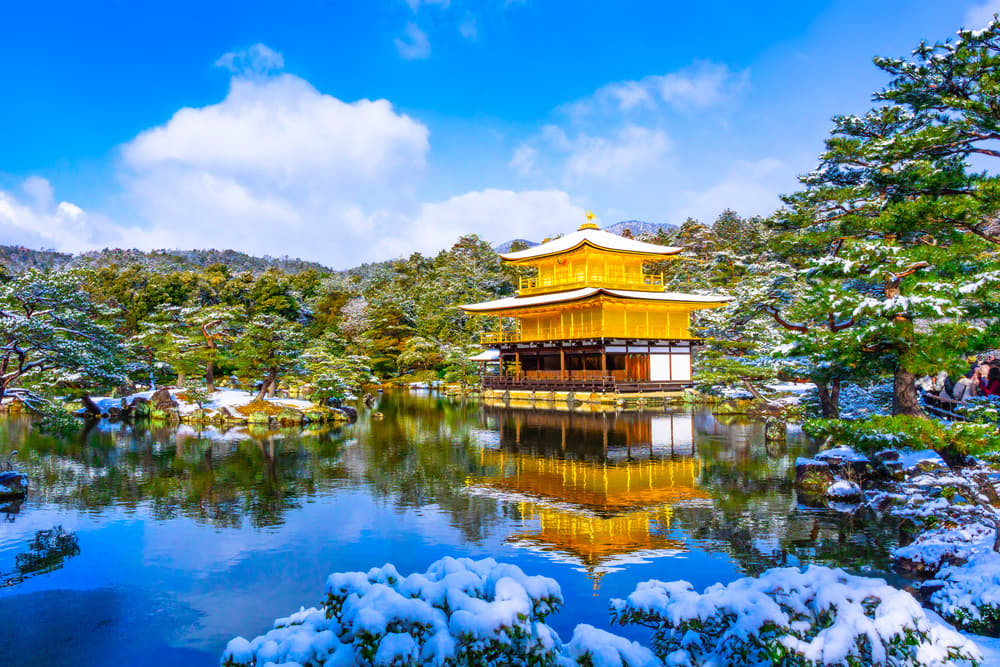Kyoto is a city of long history and culture, and one of the best places to experience the traditional beauty of Japan. Magnificent shrines and temples, tranquil Japanese gardens, and bustling markets are just a few of Kyoto’s not-to-be-missed attractions.
In this article, we will first introduce the must-visit tourist spots in Kyoto by major area and then by various themes! Please take a look at it as a reference for your trip to Kyoto.
Introduction of popular spots by area
In Kyoto, famous tourist spots such as Kinkakuji Temple and Kiyomizu Temple are scattered in various areas. In order to efficiently visit various sightseeing spots, we will introduce some popular sightseeing spots by area!
Arashiyama/Sagano Area
The Arashiyama area, a scenic spot in Kyoto, is a popular sightseeing area where visitors can experience the unique natural beauty of Kyoto. The area is characterized by an abundance of nature spots anyway, such as the Togetsu Bridge over the Katsura River and the Bamboo Grove Path, which is surrounded by bamboo.
Togetsu Bridge, Bamboo Forest, Sagano Romantic Train, Hozugawa Kudari (Boat Ride), Yakatabune of Arashiyama Toushifune, Toei Kyoto Studio Park, etc.
Togetsukyo Bridge(渡月橋)
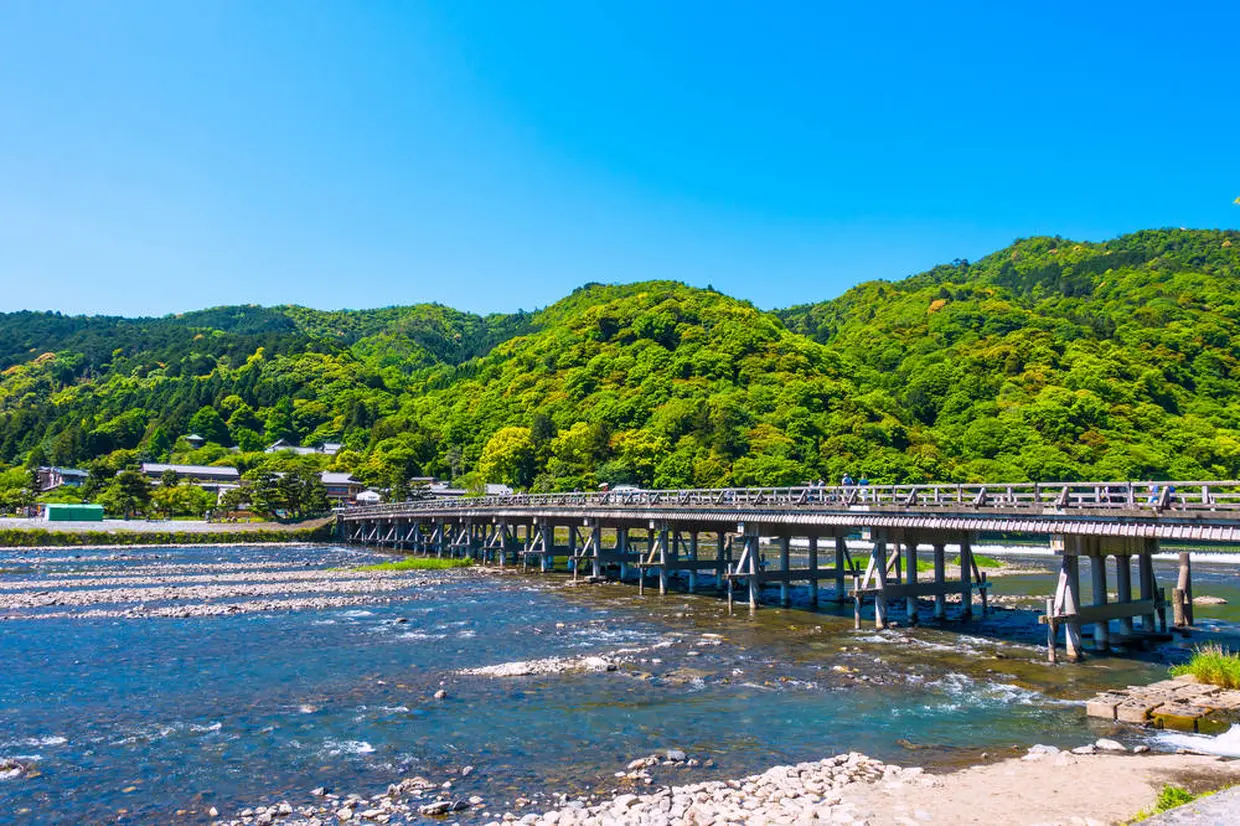
The Togetsukyo Bridge was named after the moon, which appears to be crossing the bridge. It is the symbol of Arashiyama. The view from the bridge is a perfect spot to enjoy the beauty of Japan in each of the four seasons: cherry blossoms in spring, fresh greenery in summer, autumn leaves in fall, and snow in winter.
Bamboo Forest(竹林の小径)
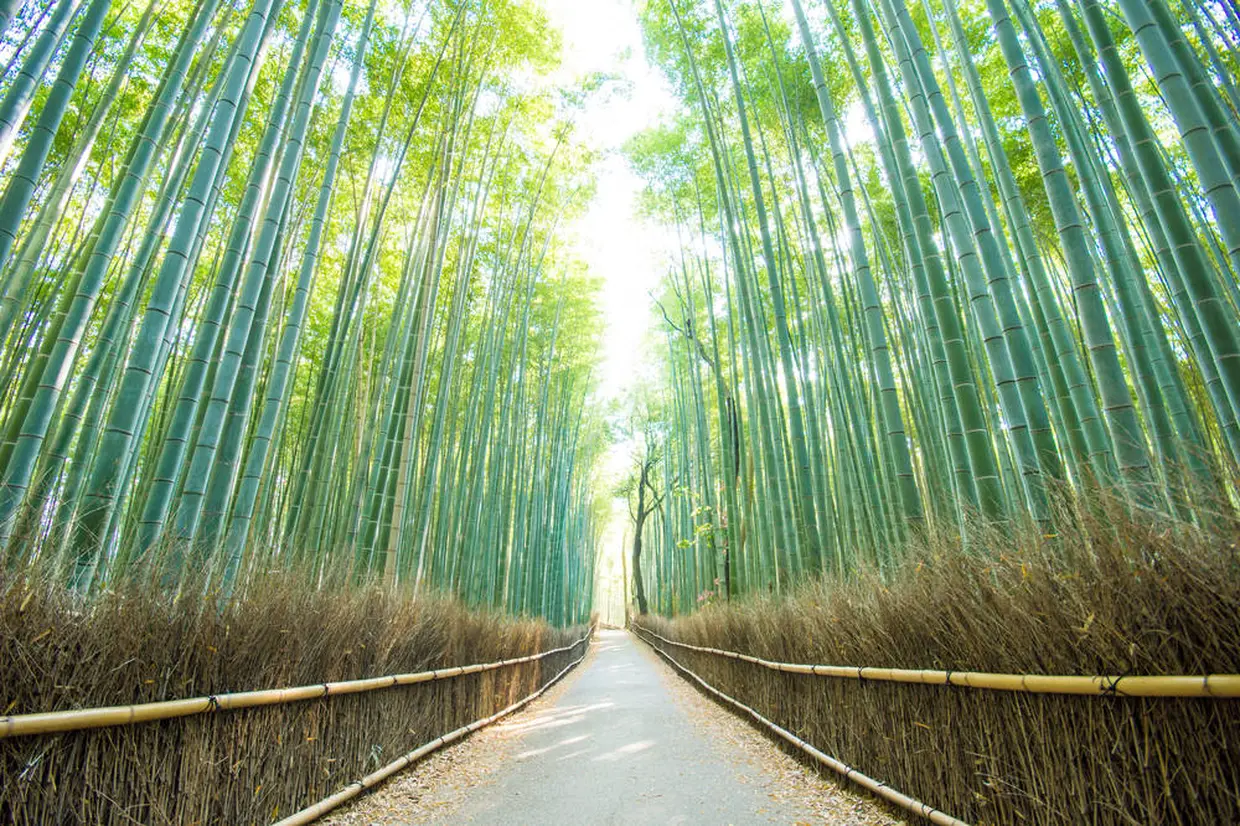
One of the most popular walking spots in Arashiyama and Sagano is the bamboo grove path. Tens of thousands of bamboos grow along the 400-meter-long path, providing a typically Japanese landscape. It is also famous as a photo spot, but it is always crowded these days due to the increasing number of tourists. We recommend that you visit early in the morning if you want to take pictures of beautiful scenery.
Sagano Romantic train(嵯峨野トロッコ列車)
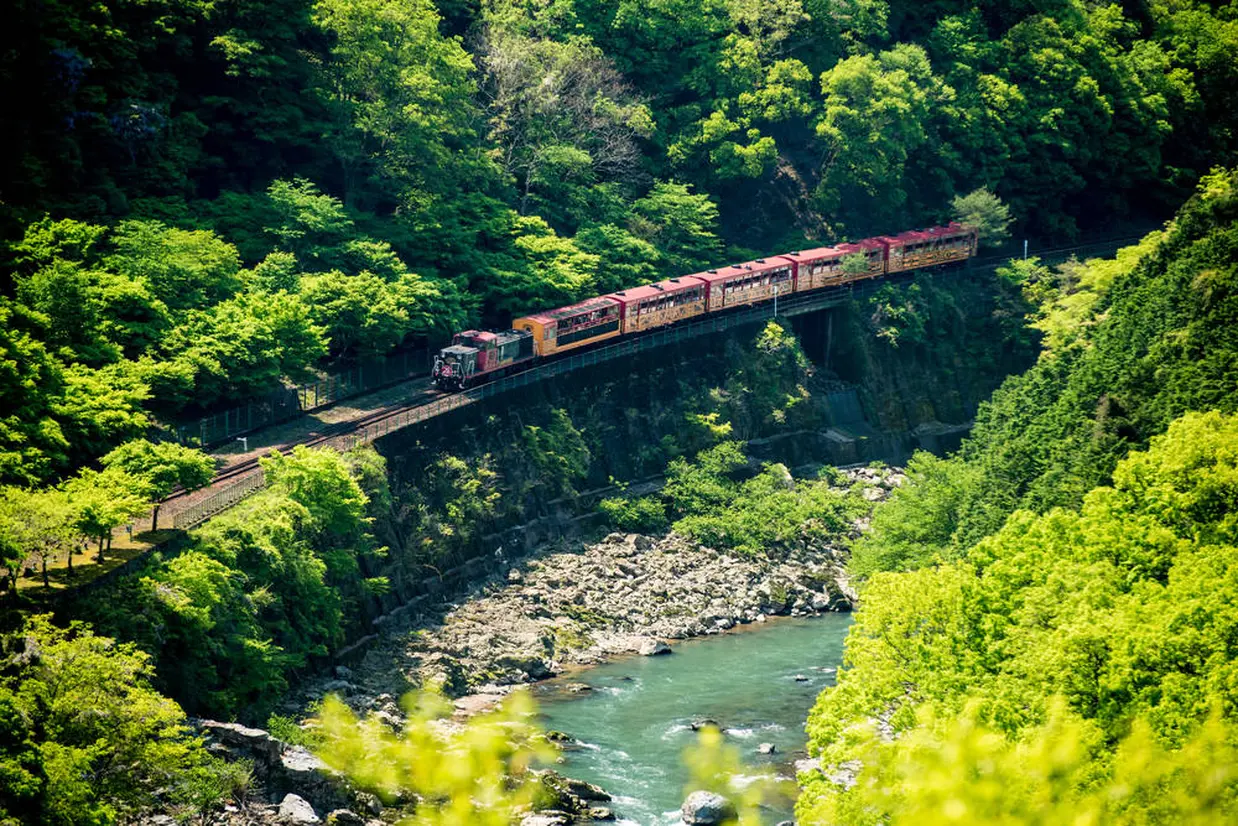
The Sagano Romantic train is a sightseeing train that rumbles along the Hozu River. The speed is about 25 km/h, which gives passengers plenty of time to enjoy the scenery, and the train slows down in areas with beautiful scenery, so passengers can enjoy a relaxing view of the beautiful valley from inside the train. The standard course is to take the trolley from Arashiyama and return on the Hozugawa River.
Hozugawa-kudari(Boat Ride)(保津川下り)
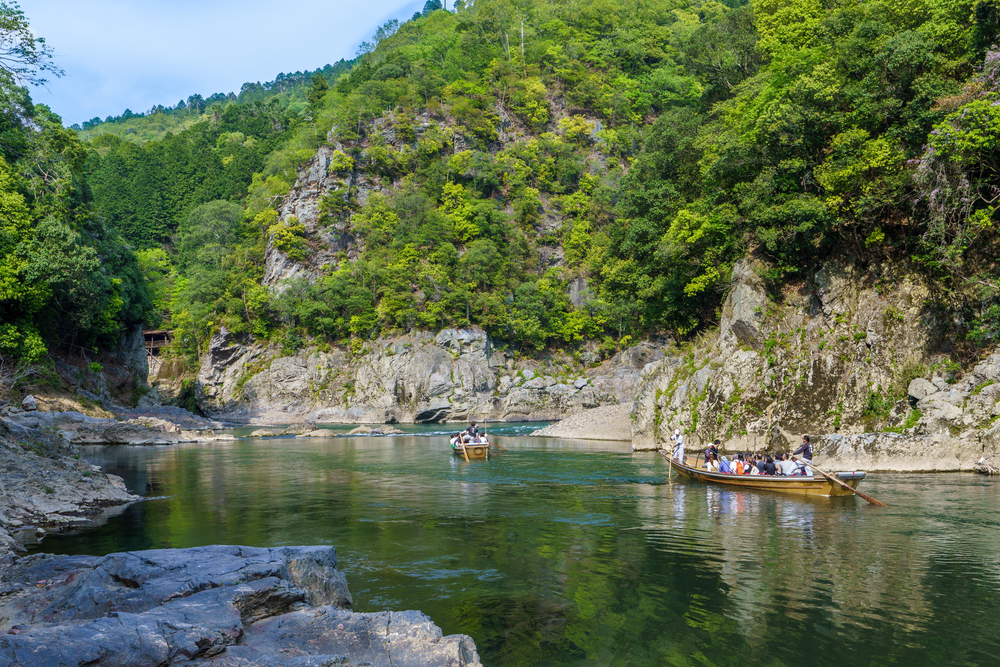
Although Hozugawa-kudari haveagood-holiday been used since before the capital was built in Kyoto as a means of transporting goods to Kyoto and Osaka, they are now popular as a sightseeing tour to enjoy the beautiful nature of the Hozu River Gorge.
On the 16-km (2-hour) descent from Kameoka to Arashiyama, you will feel the thrill of passing through large rocks and mountains, as well as the energy of nature.
Kinkakuji Temple, Kamigamo Jinja Shrine, Ryoanji Temple Area
Kinkaku-ji Temple, Kamigamo Jinja Shrine, and Ryoan-ji Temple are located near the foot of Mt Kinugasa. The area is a bit far from the city center, and there are few restaurants or souvenir stores. It is a particularly good sightseeing spot for those who want to visit temples and shrines in a relaxed atmosphere.
Kinkakuji Temple, Kamigamo Timja Shrine, Ryoanji Temple, Ninnaji Temple, Kitano Tenmangu Shrine, Hirano Jinja Shrine, etc.
Kinkaku-ji Temple (金閣寺)

Kinkaku-ji Temple is the first temple that many people think of when they hear the word Kyoto. Although the temple is officially called “Rokuon-ji”, it came to be called “Kinkaku-ji” because of the famous golden “Kinkaku” building on the temple grounds.
Visitors can enjoy the seasonal beauty of the temple, the “upside-down Golden Pavilion” reflected in mirror pond, and the Chisen Kaiyu style garden (a style of Japanese garden with a path around a central pond and spring), all of which are beautiful no matter what time of year you visit. The symbol of Kinkaku-ji, the Golden Pavilion, is not open to the public. Enjoy the view from outside.

Kamigamo Jinja Shrine (上賀茂神社)

Kamigamo Jinja Shrine is officially called Kamo Wakeikazuchi Jinja Shrine. The word “Wakeikazuchi” means “god so powerful that he can separate thunder” and has been worshipped since ancient times as a god to ward off evil and misfortune, and to ensure victory. The extensive grounds, which include two national treasures and 41 important cultural properties, are all registered as a UNESCO World Heritage site.
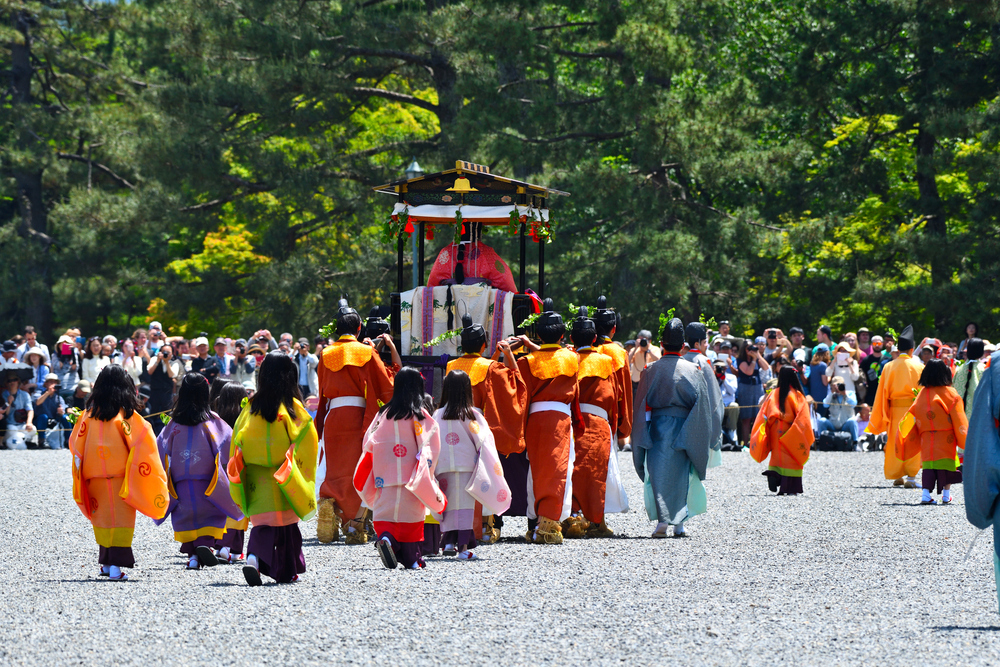
Kamigamo Shrine is also the site of the famous Aoi Matsuri festival in Kyoto. The Aoi Matsuri is an annual festival of the Kamomioya Jinja Shrine (Shimogamo Jinja Shrine) and the Kamo Kamo Wakeikazuchi Jinja Shrine (Kamigamo Jinja Shrine) that began more than 1,500 years ago, and is held in May.Various events are held starting in May, and on May 15, visitors can see an 8-km-long procession of people dressed in the costumes of Heian aristocrats.
Ryoan-ji Temple (龍安寺)
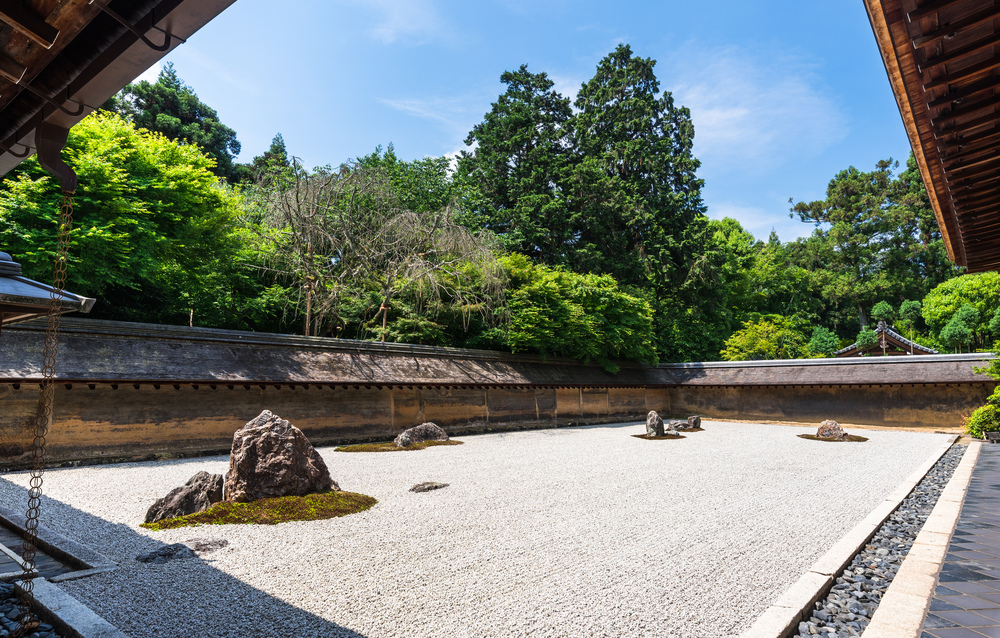
Ryoan-ji Temple, registered as a World Heritage site, is famous for its rock garden called karesansui (dry landscape garden). Karesansui is a Japanese garden that uses only sand and stones to create a landscape of mountains and water without any water. Karesansui at Ryoan-ji Temple became world famous as a “rock garden” after Queen Elizabeth II of England praised it highly when she visited Kyoto.
Area around Shimogamo-jinja Shrine, Ginkakuji Temple and Kyoto Imperial Palace
The area around Shimogamo-jinja Shrine, Ginkaku-ji Temple, and the Kyoto Imperial Palace is located in the eastern part of Kyoto City, extending from the foot of the mountain toward the center of Kyoto City.
There are many large universities in this area, and the area is characterized by a blend of residential and tourist areas. It is relatively less crowded than the Kiyomizu-dera Temple area, and you can feel the local people’s activities in a moderately touristy and moderately touristy area.
Ginkakuji Temple, Philosopher’s Path, Kyoto Imperial Palace, Shimogamo jjnja Shrine, Kamogawa Delta, Kamo Mitarashi Chaya, etc.
Ginkakuji Temple(銀閣寺)
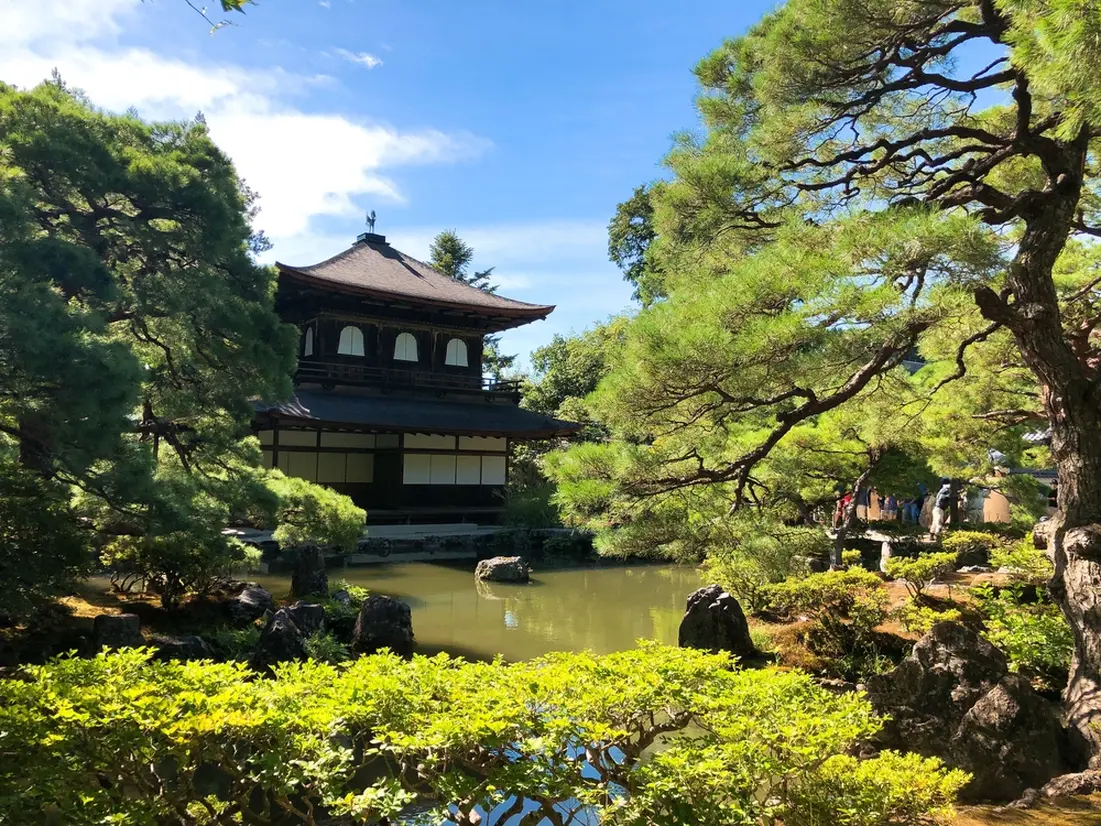
This temple, famous for the Ginkaku-ji Temple, is officially called “Higashiyama Jisho-ji Temple. The name “Ginkaku-ji Temple” suggests a silvery appearance, just as Kinkaku-ji Temple in gold, but in fact it has a majestic “wabi sabi” appearance. Ginkaku-ji Temple is known as a representative building of the Higashiyama culture in which it was built.
Kyoto Imperial Palace / Kyoto Gyoen National Garden (京都御所 / 京都御苑)

The Kyoto Imperial Palace, the residence of Japan’s emperors for more than 500 years, is an essential part of Japanese history, and has been open to the public year-round since 2016, with no application or entrance fee required.

The Kyoto Gyoen National Garden surrounding the Kyoto Imperial Palace are also a great place to stroll and enjoy the abundant greenery. The Kyoto Gyoen National Garden is so vast that just circling it is a good workout. You can see many people who live in the area enjoying daily strolls, jogging, and cycling around the garden.
Shimogamo jinja Shrine(下鴨神社)

Shimogamo-jinja Shrine, officially called Kamomioya-jinja Shrine, is located near the Kamogawa Delta where the Kamogawa and Takanogawa Rivers converge. It is registered as one of the UNESCO World Cultural Heritage sites, and the main shrine, divided into west and east sections, is registered as a national treasure.
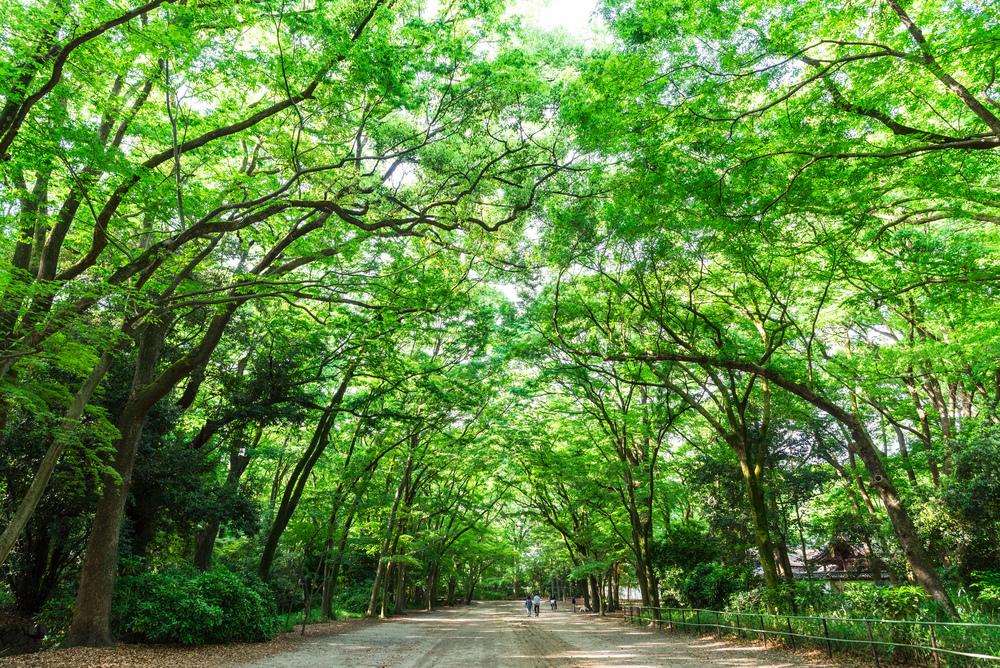
A vast forest called Tadasu-no-mori covers the precincts of Shimogamo-jinja Shrine. A stream flows through the forest, which is filled with many trees, making it a very pleasant place to walk around.
Uji Area
The Uji area, which can be reached in about 16 minutes from Kyoto Station by rapid train on the JR Nara Line, is famous for its Heian culture and Uji tea.
Uji is home to many sightseeing spots such as Byodo-in Temple, a World Heritage site, Ujigami-jinja Shrine, and Mimuroto-ji Temple. You should not miss the matcha (powdered green tea) gourmet food, Tea Harvesting experience, and matcha-making experience that are only possible in this tea-producing region. This is an area where you can enjoy both Japanese culture and gourmet food, and it is definitely a place you should visit when you travel to Kyoto.
Byodoin Temple, Uji-jinja Shrine, Ujigami-jinja Shrine, Mimuroto-ji Temple, Nintendo Museum, Chazuna, Nakamura Tokichi Main Store, etc.
Byodo-in Temple (平等院)

Byodo-in Temple was opened in 1052. It is registered as a World Heritage site and has numerous national treasures. The most famous of these is the Phoenix Hall (Houou-do), which is designed on the Japanese ten-yen coin. The Phoenix Hall (Houou-do) was renovated in 2014, and visitors can now enjoy an appearance closer to the Heian period when the temple was founded.
Uji-jinja Shrine(宇治神社)
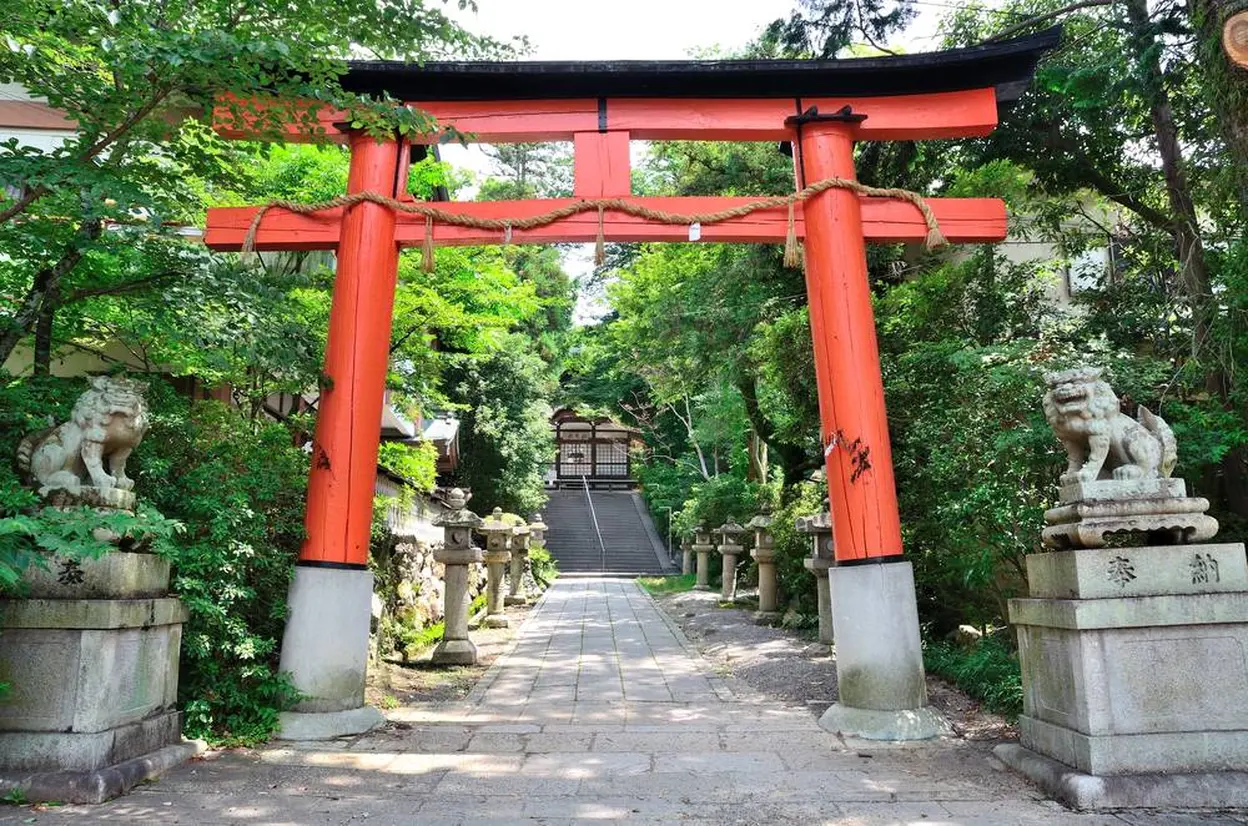
Uji Shrine is dedicated to the god of learning. The main shrine is registered as a National Important Cultural Property. One of the highlights of Uji Shrine is the “Mikaikaeri-Usagi,” or rabbit figurines that are said to be the messengers of the god! They are said to be good luck charms for good marriage as they guide visitors to the right path. You can’t miss the cute rabbit omikuji (fortune slip).
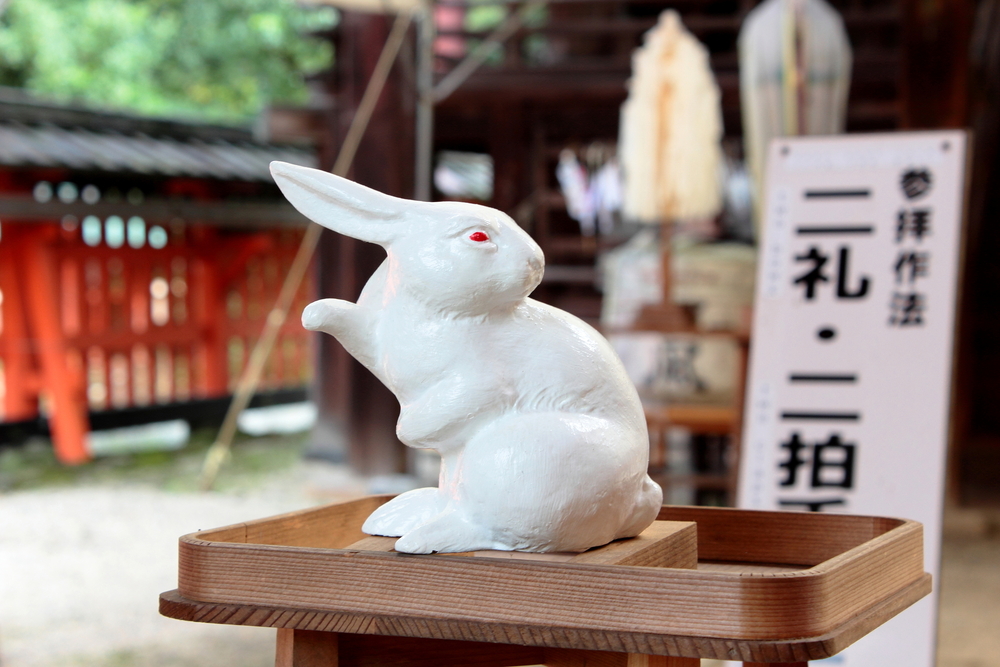
Incidentally, the World Heritage Site “Ujigami Shrine” next door is also a spot that rabbit lovers should not miss. Why not visit there together?
Nakamura Tokichi Main Store(中村藤吉 本店)
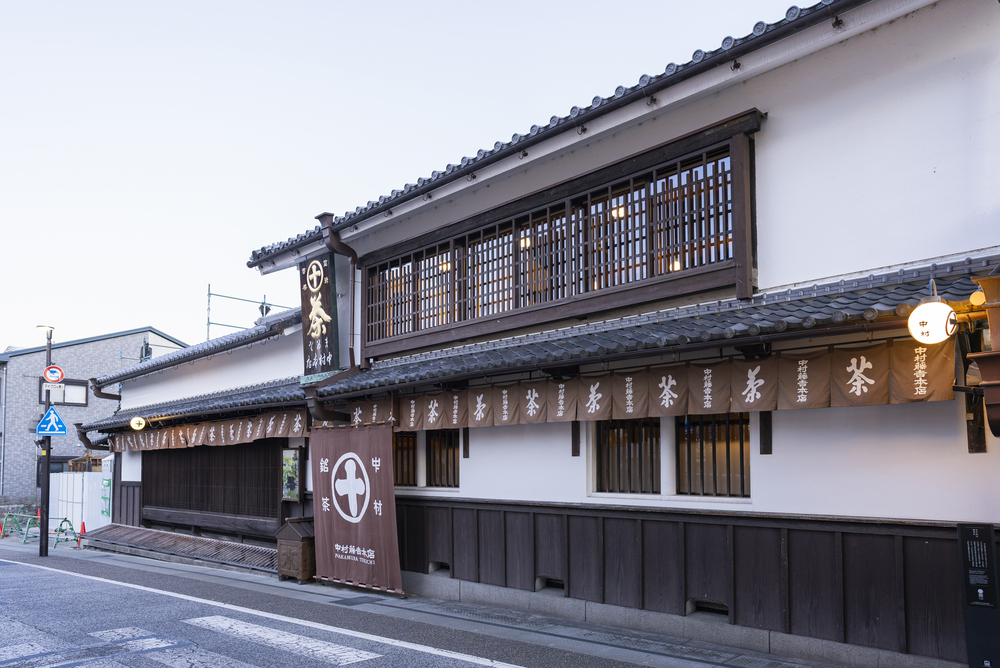
If you want to fully enjoy Uji tea sweets, Nakamura Tokichi’s “Namacha Jelly” is recommended. The clear texture and transparency of the glossy jelly and shiratama (white rice balls), available in hojicha (green tea) and matcha (powdered green tea) options, are unforgettable once you try them. For those who want to fully enjoy tea, there is a plan that includes ground tea and a tea ceremony experience.
Fushimi Area
The Fushimi area, located a few minutes by train from Kyoto Station, is a prosperous sake brewing town. Lined with old sake breweries, the scenery is like stepping back in time.
Fushimi Inari-taisha Shrine, Inari Saryo, Fushimi Sake Brewery Street, Jujukoku-bune, Sanjukoku-bune, Daigoji Temple, etc.
Fushimi Inari-taisha shrine (伏見稲荷退社)
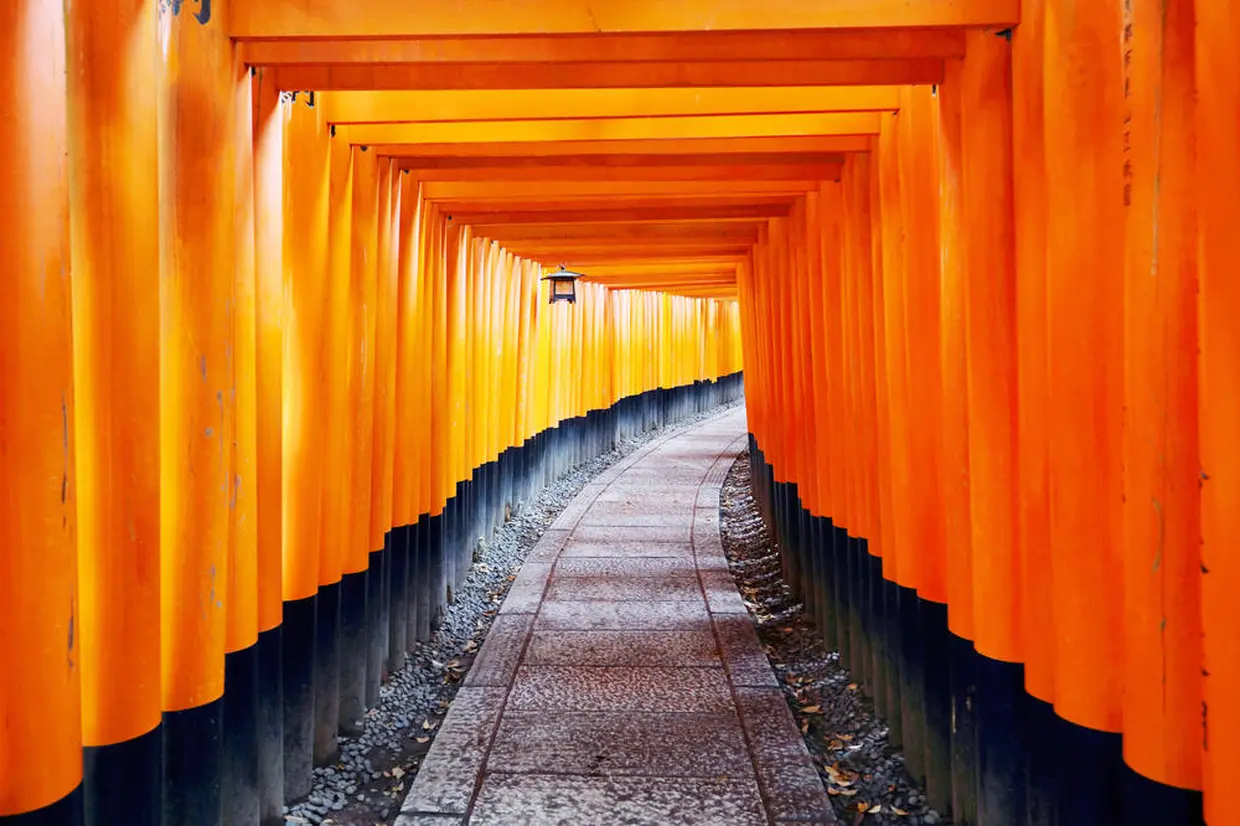
Fushimi Inari Shrine is a popular tourist attraction in Japan and abroad. The reason for its popularity is the beauty of the thousand torii gates! The endless rows of torii gates painted in vermilion are very photogenic, and many people enjoy taking pictures with the torii gates.
Inari Saryo (稲荷茶寮)
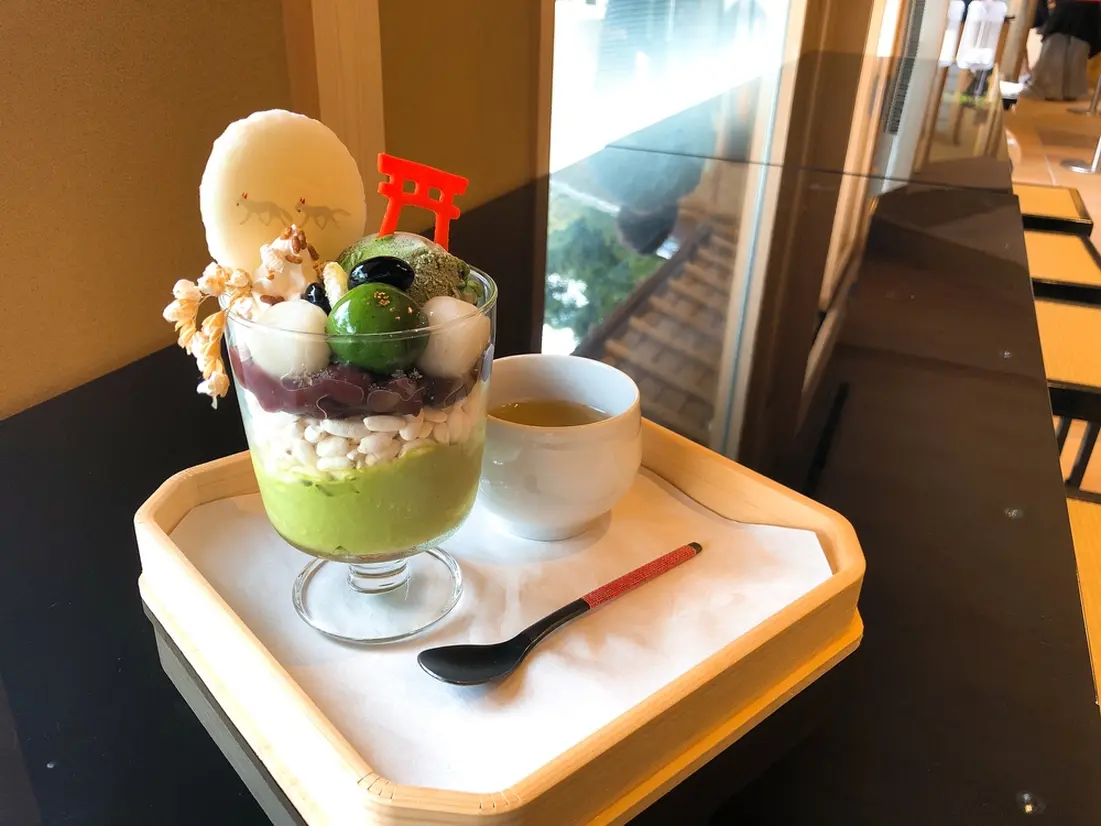
When visiting Fushimi Inari-Taisha Shrine, it is recommended to enjoy Japanese sweets at the Japanese Tea Café in Teichoan, a free rest area on the shrine grounds. The popular menu item is the “Inari Parfait” with a red torii gate, a fox, and ears of rice. It has a very Fushimi Inari-like appearance. From inside the restaurant, you can see Mt. Inari and the lush garden, and if you sit on the terrace, you can hear the murmuring of the river and the chirping of birds.
Fushimi Sake Brewery Street (伏見酒蔵の街並み)

Fushimi, blessed with good groundwater, is famous as a sake brewing area. Sake brewing is said to have begun in earnest in the early Edo period (1603-1868), and even today there are many sake breweries and stores in former sake breweries. Although it is a short distance from Fushimi Inari Taisha Shrine, the area has a very pleasant atmosphere, and we recommend that you take the time to visit.
Jujukoku-bune/ Sanjukoku-bune (十石舟 / 三十石舟)
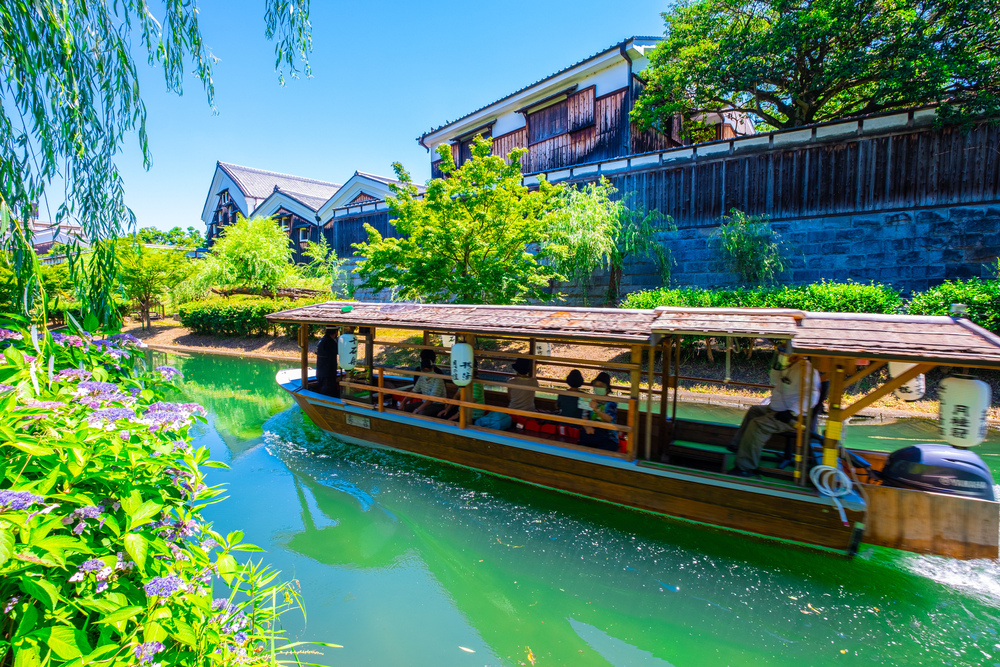
The cityscape of Fushimi can be enjoyed from the river. The canal, which was used for transportation during the Edo period (1603-1868), is now used for sightseeing boats to enjoy the scenery of Fushimi. You can enjoy the seasonal scenery of cherry blossoms in spring, hydrangea and willow trees in summer, and autumn leaves in fall, while taking the time to experience Fushimi as it used to be a port town. Please note that the bus is closed in winter.
Higashiyama Area
Higashiyama area is located on the east side of Kyoto City, along the north and south sides of Higashiyama mountain range. There are many ways to enjoy the area, such as a course from Kiyomizu-dera Temple down Sannenzaka and Ninenzaka slopes to Kodai-ji Temple and Yasaka-jinja Shrine before heading to Gion, or a course from Nanzen-ji Temple in the Okazaki direction to Ginkaku-ji Temple via Philosophical Path, while enjoying nature.
Kiyomizu-dera Temple, Kodaiji Temple, Sanneizaka, Ninneizaka, Yasaka-no-to, Yasaka Koshindo, Sanjusangendo Temple, Kyoto National Museum, etc.
Kiyomizu-dera Temple (清水寺)
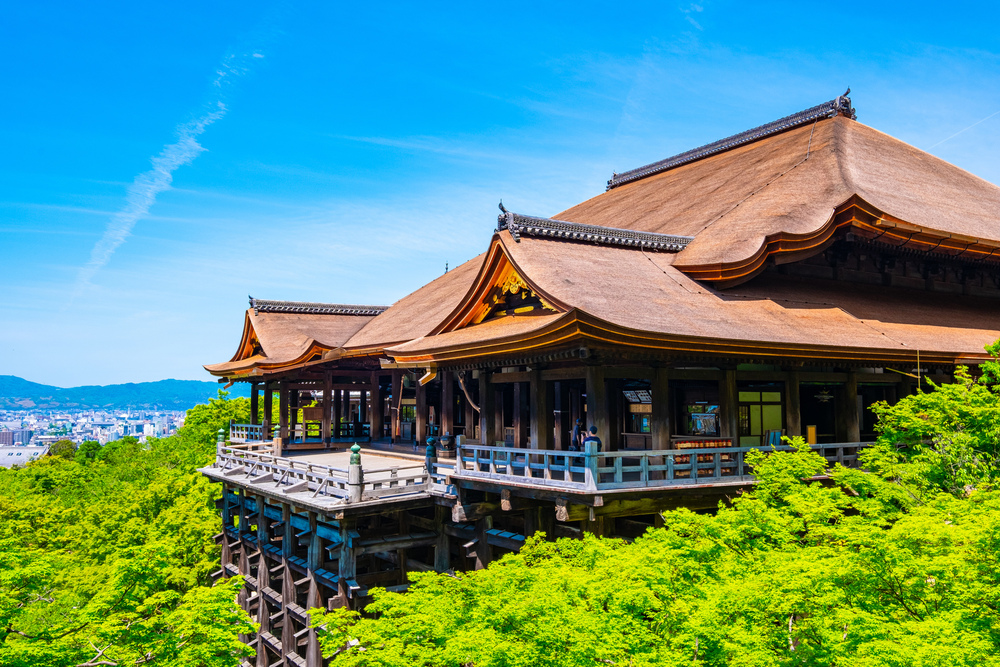
Kiyomizu Temple is one of the most popular sightseeing spots in Kyoto. There is a Japanese proverb that says, “Jump off the stage at Kiyomizu,” and the “stage at Kiyomizu” refers to the stage in front of the main hall of Kiyomizu Temple. The stage is built on a cliff and is supported by 18 pillars made of 400-year-old zelkova trees. Not a single nail is used in the pillars, which is astonishing. The stage commands a panoramic view of the city of Kyoto, and the scenery is enchanting to behold.

There are a number of other attractions on the Kiyomizu Temple grounds. The Niomon Gate, which also serves as a blindfold to prevent visitors from looking down on the Imperial Palace from the Kiyomizu stage, and the large three-story pagoda, said to be the symbol of Higashiyama, are overwhelming architectural features. In addition, be sure to visit power spots such as Otowa Falls, which is said to be beneficial for “love,” “studies,” and “health,” and Jishu Shrine, which is popular among young women and couples as a place for matchmaking, located on the grounds of the temple.
Sanneizaka (Sannenzaka) (産寧坂)
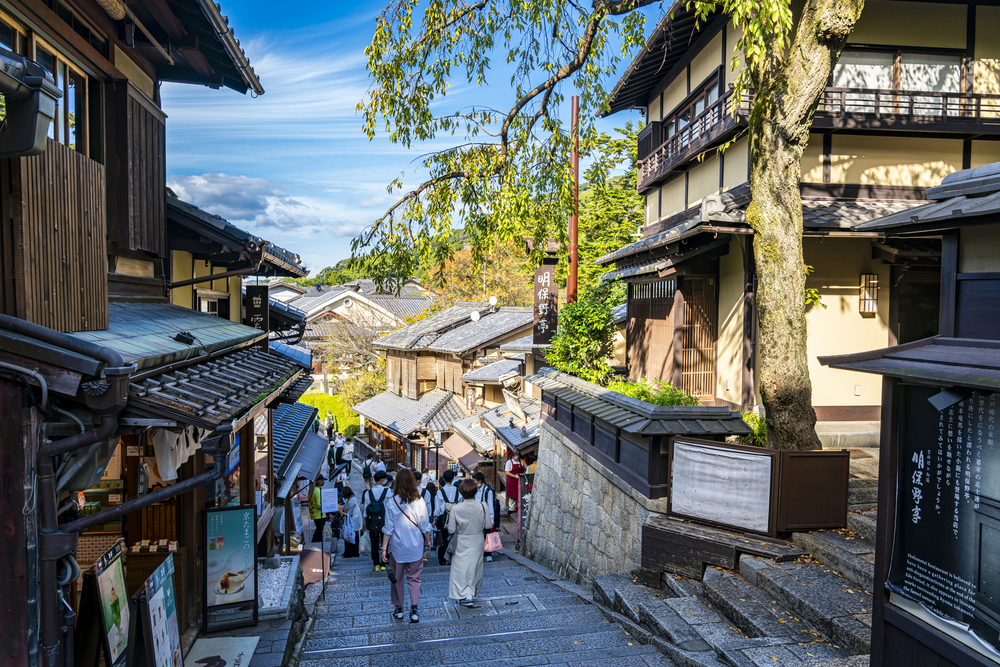
One of the pleasures of visiting a large shrine is the bustle of the approach. Sanneizaka is a slope leading to Kiyomizu-dera Temple and is a typical stone-paved street in Kyoto. The name “Sanneizaka” comes from the fact that people used to visit Kiyomizu-dera Temple via Sanneizaka and wish for a “peaceful delivery” of their child. This street is lined with Kyoto-style machiya (townhouses) cafes and souvenir shops, but recently there has also been an increase in stores selling food that can be eaten and walked around, making it a fun area just to walk around.
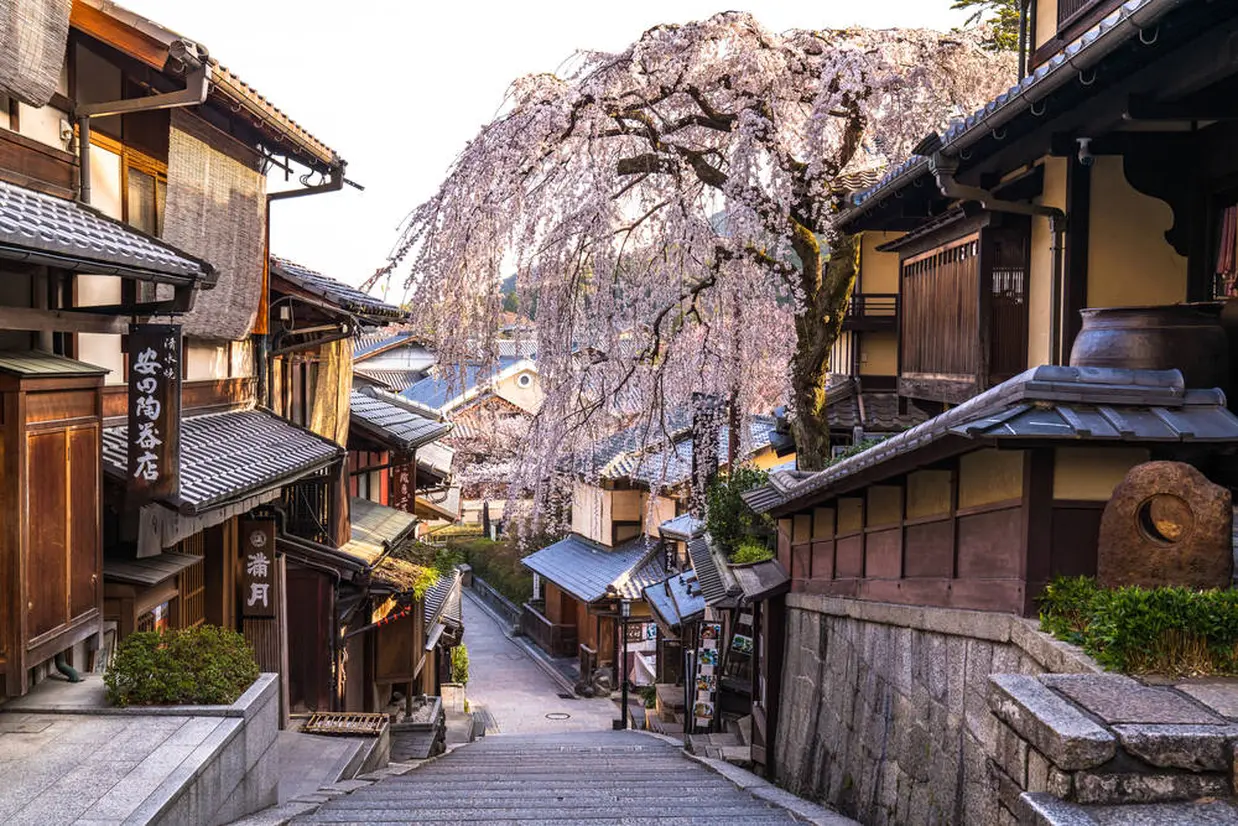
The cityscape continues to be a typical Kyoto scene, and it is picturesque no matter where you take pictures, but it may be difficult to take pictures slowly during the daytime because there are too many tourists. If you want to take pictures in a calm atmosphere, we recommend that you visit early in the morning.
Yasaka Koshindo(八坂庚申堂)
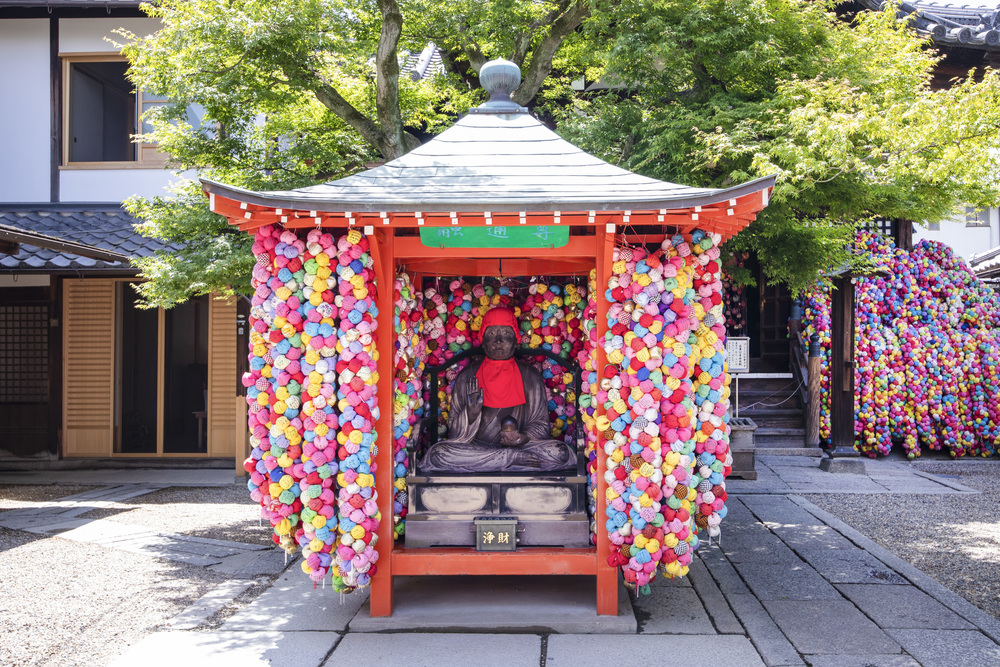
Yasaka Koshindo, located near Yasaka-no-to, has become a popular photo spot for women in recent years. Although its official name is “Kongoji Koshindo,” it is nicknamed “Yasaka no Koshin-san” by the locals.
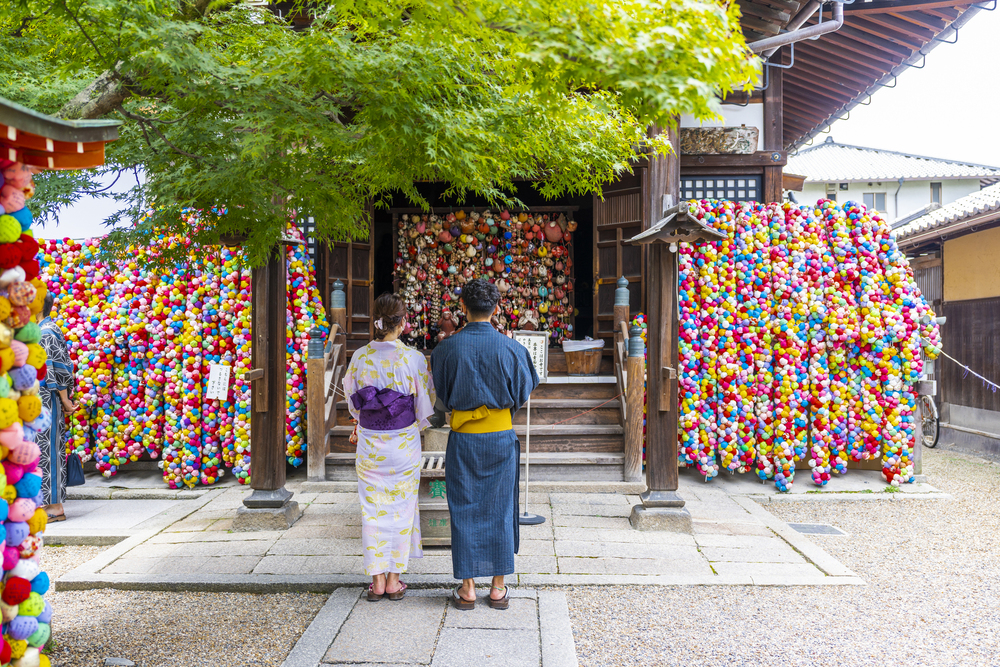
It is one of the most populous spots among the many spots in Kyoto. Taking pictures in kimono or yukata is also a great way to commemorate your visit.
Gion Area
Gion is an area where you can enjoy a typical Kyoto townscape. The cobblestone walkways, such as Hanamikoji lined with ochaya (tea shops) and the Gion Shirakawa River with its beautiful willows along the river, are all filled with the Kyoto atmosphere. There are also many famous shrines and temples here and there that you should visit at least once. These are the staples of Kyoto sightseeing, but no matter how many times you visit, you will always be impressed by the beauty of the city.
Yasaka-jinja Shrine, Maruyama Park, Hanamikoji Street, Gion Shirakawa, Kenninji Temple, Yasui Kompiragu, etc.
Yasaka-jinja Shrine (八坂神社)
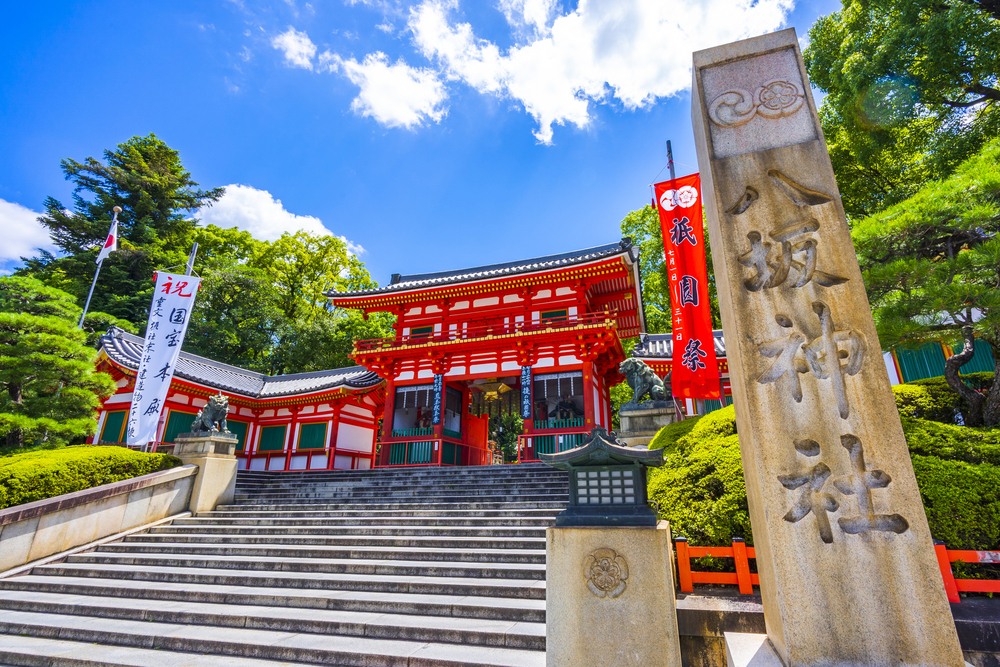
Yasaka Shrine, also known as “Gion-san,” is the symbol of Gion and beloved by the people of Kyoto. From the west tower gate facing Shijo Dori, you can see the lively Gion shopping district.
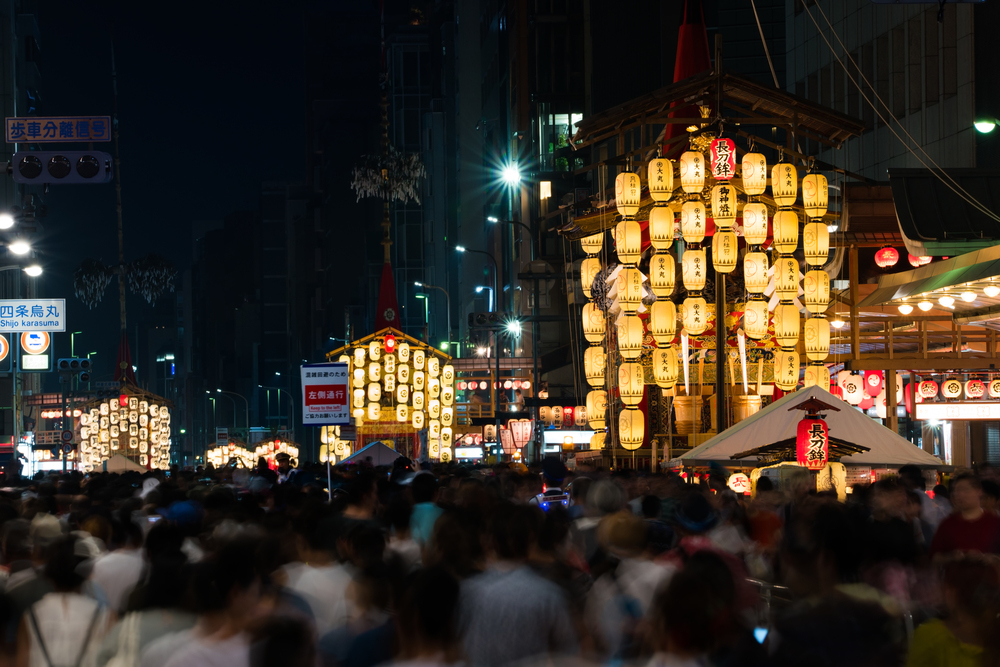
This shrine is also the site of the Gion Matsuri Festival, one of the three major festivals in Japan, which is a large-scale, month-long festival held annually in July.
Maruyama Park (円山公園)

Maruyama Park is a park rich in nature that stretches behind Yasaka Shrine.
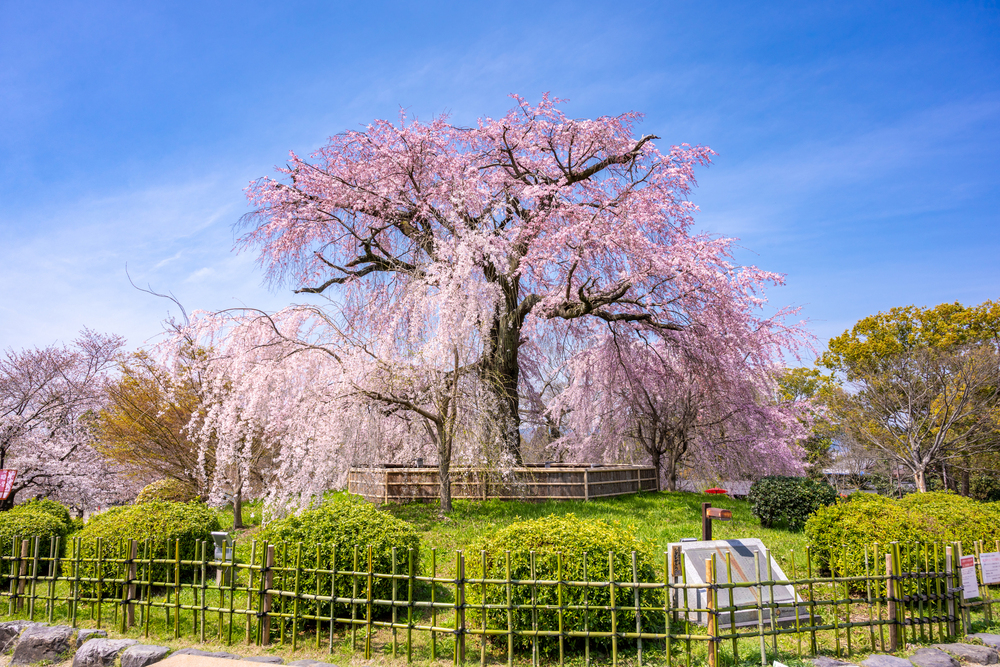
It is also famous as one of the best cherry blossom viewing spots in Kyoto, and is lit up during the cherry blossom viewing season, making it popular as “Gion no Yozakura” (cherry blossoms at night in Gion). The most famous cherry tree is the large weeping cherry tree known as “Gion Shidare”.

Maruyama Park is also beautiful in the fall, and the reflections of the autumn leaves on Hyotan Pond in the park and the stone steps leading to the park are worth seeing. The park is within walking distance of Yasaka-jinja Shrine, Chion-in Temple, and Kodai-ji Temple, making it a perfect place to rest your feet between visits to temples and shrines.
Hanami-koji Street (花見小路通)
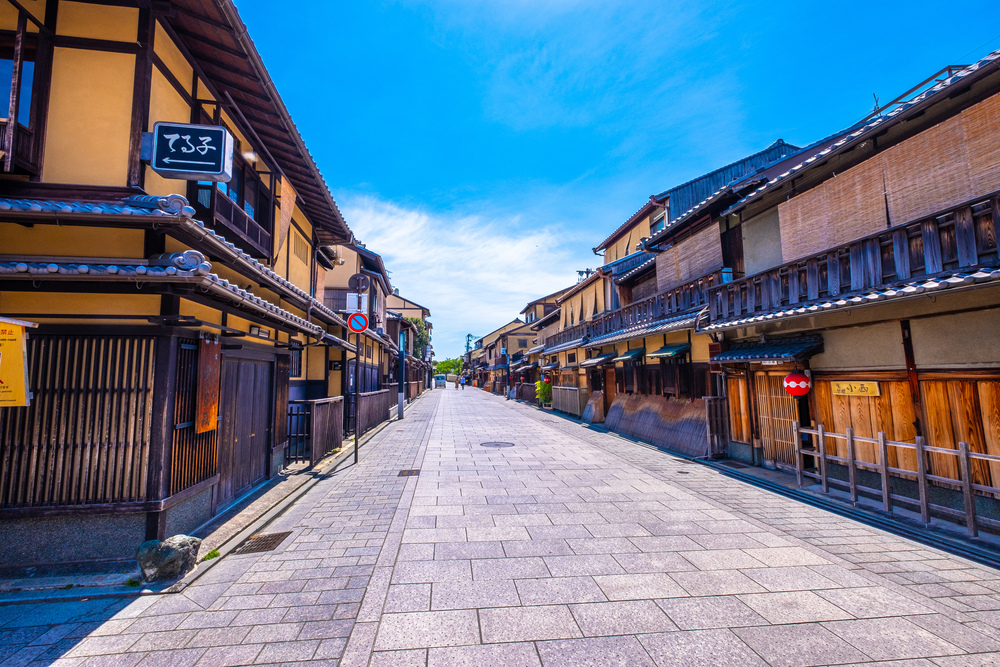
Hanami-koji Street is lined with cobblestone pavement and Kyo-machiya (Kyoto-style townhouses). It is said to be the main street of Gion, and now electric wires are buried underground to maintain the Kyoto-like scenery.

There are also some nice streets off Hanamikoji Dori with fashionable cafes, so it is recommended to take a stroll around. However, there are many private roads, so please be respectful of other visitors.
Okazaki Area
The Okazaki area is located between the downtown area of Kyoto City and the foot of Higashiyama Mountain. It is a calm area with famous shrines and temples such as Heian Jingu Shrine, Nanzen-ji Temple and Eikan-do Temple, as well as cultural facilities such as museums and zoos.
Heian Shrine, Okazaki Shrine, National Museum of Modern Art, Kyoto, Kyocera Museum of Art, Kyoto Zoo, Eikando, Nanzenji Temple, etc.
Heian-jingu Shrine (平安神宮)
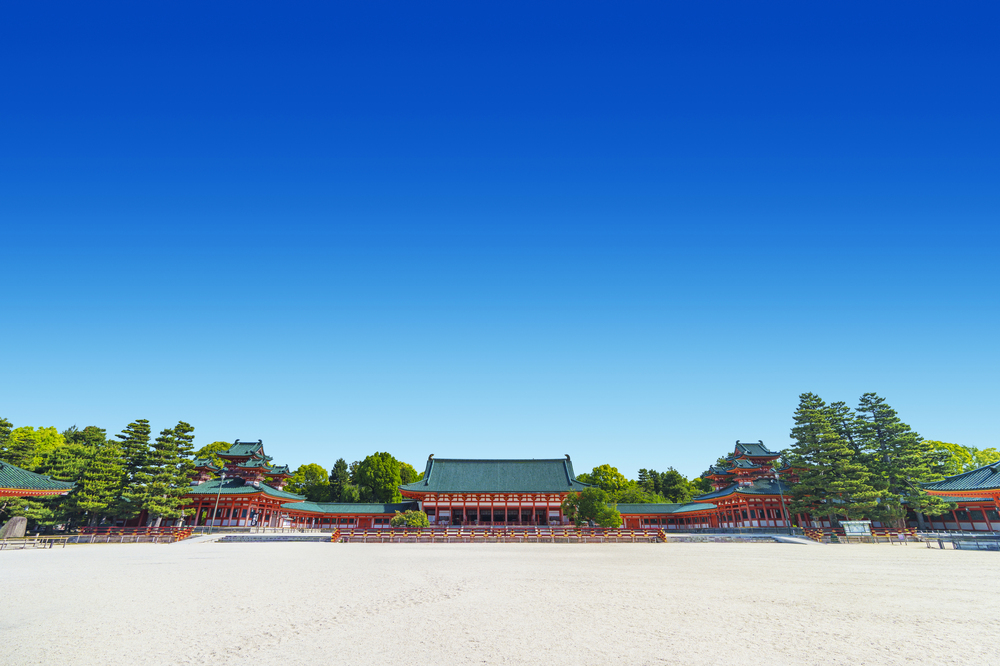
Heian-jingu Shrine was built in 1895 and is a relatively new shrine in Kyoto. It has a “Shinen Garden,” which is the culmination of the landscaping techniques of the time, “Daigokuden,” a beautiful vermilion shrine building, and the “Otorii”, which has become a symbol of the city of Okazaki.
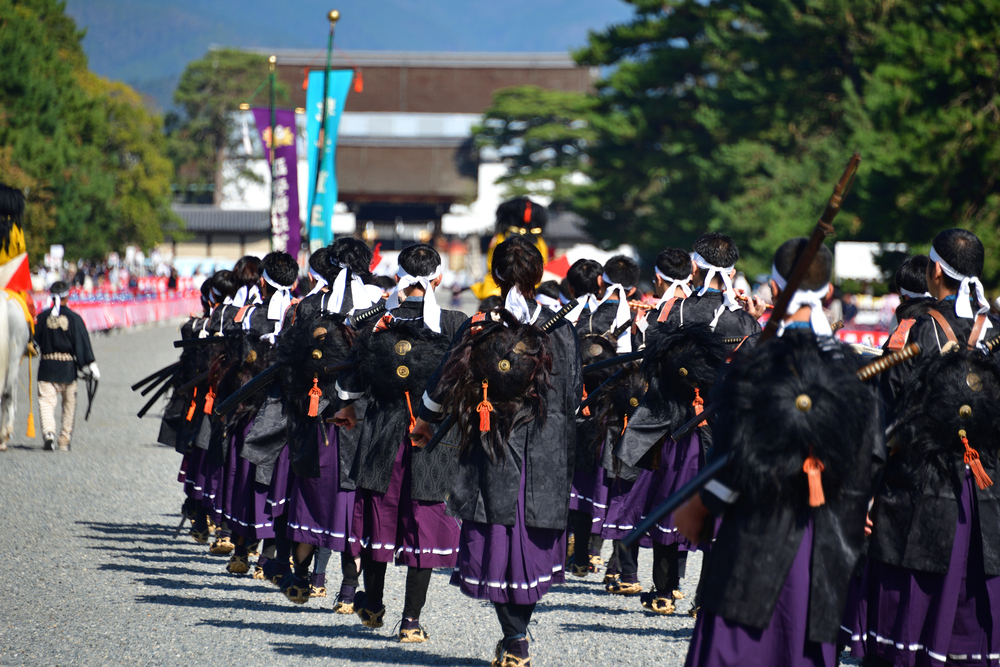
The shrine is also famous as the site of the Jidai Matsuri, one of the three major festivals in Kyoto along with the Aoi Matsuri and the Gion Matsuri. The Jidai Matsuri is a festival that allows visitors to see the itinerant history of the times during the approximately 1,000 years that Kyoto was the capital of Japan. The festival is usually held on October 22 every year, postponed in case of rain.
Okazaki Shrine (岡崎神社)
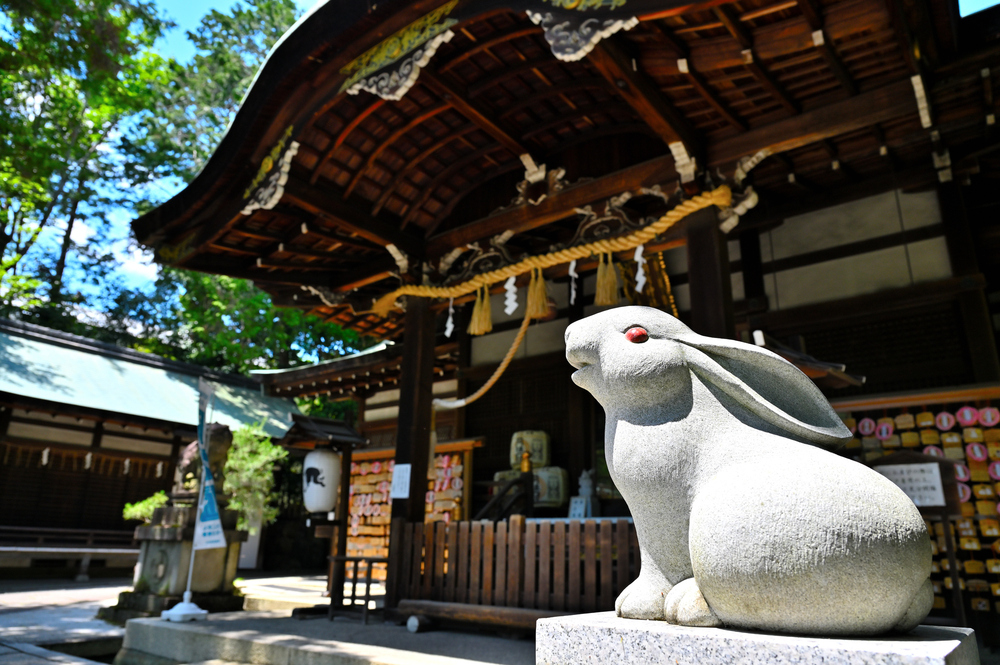
Located near Heian Shrine, Okazaki Shrine is one of the shrines built to protect Heian-kyo. In recent years, the shrine has become the talk of the town as a rabbit-filled shrine.
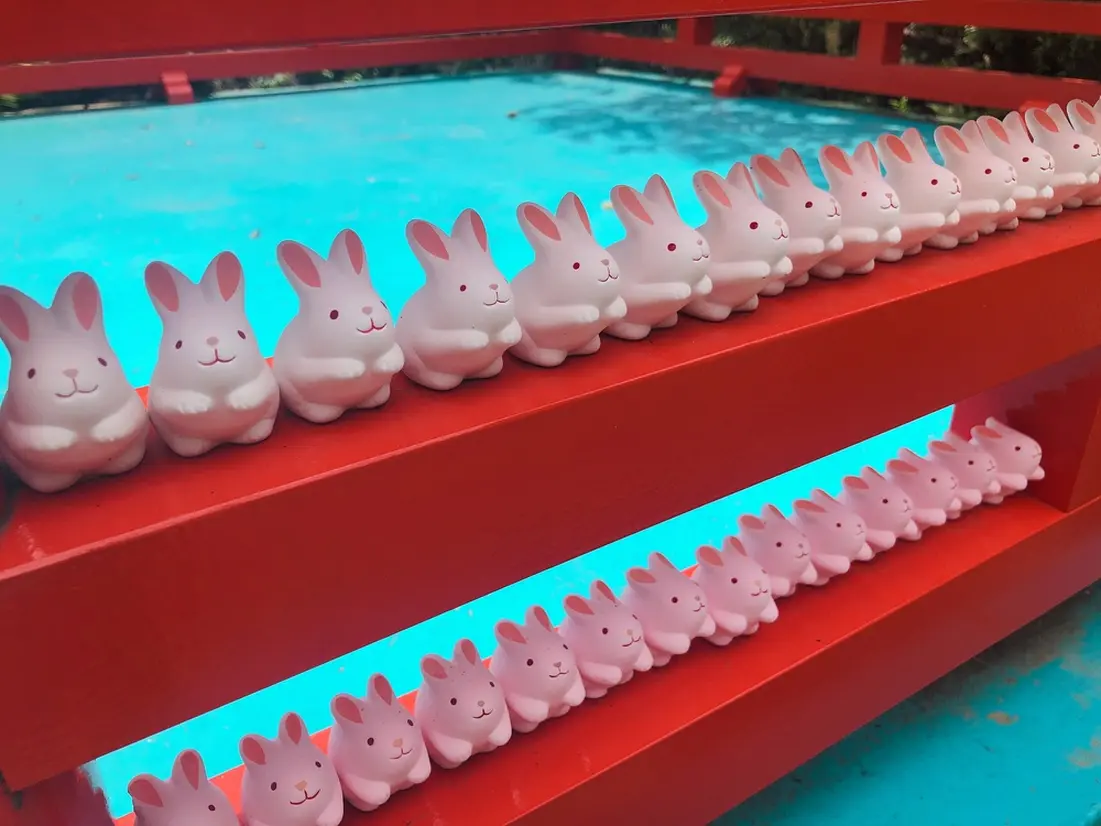
The “Usagi-mikuji” (rabbit omikuji) is a representative of the cute rabbits of Okazaki Shrine. The ceramic rabbit contains a omikuji, and you can take the rabbit home along with the omikuji. The round shape of the rabbit is very cute and makes a perfect memento of your trip!
Nanzen-ji Temple (南禅寺)

When you visit Nanzen-ji Temple, the first thing you will see is the 22-meter-high Sanmon Gate. Its overwhelming size and powerful pillars give it an overwhelmingly massive appearance.
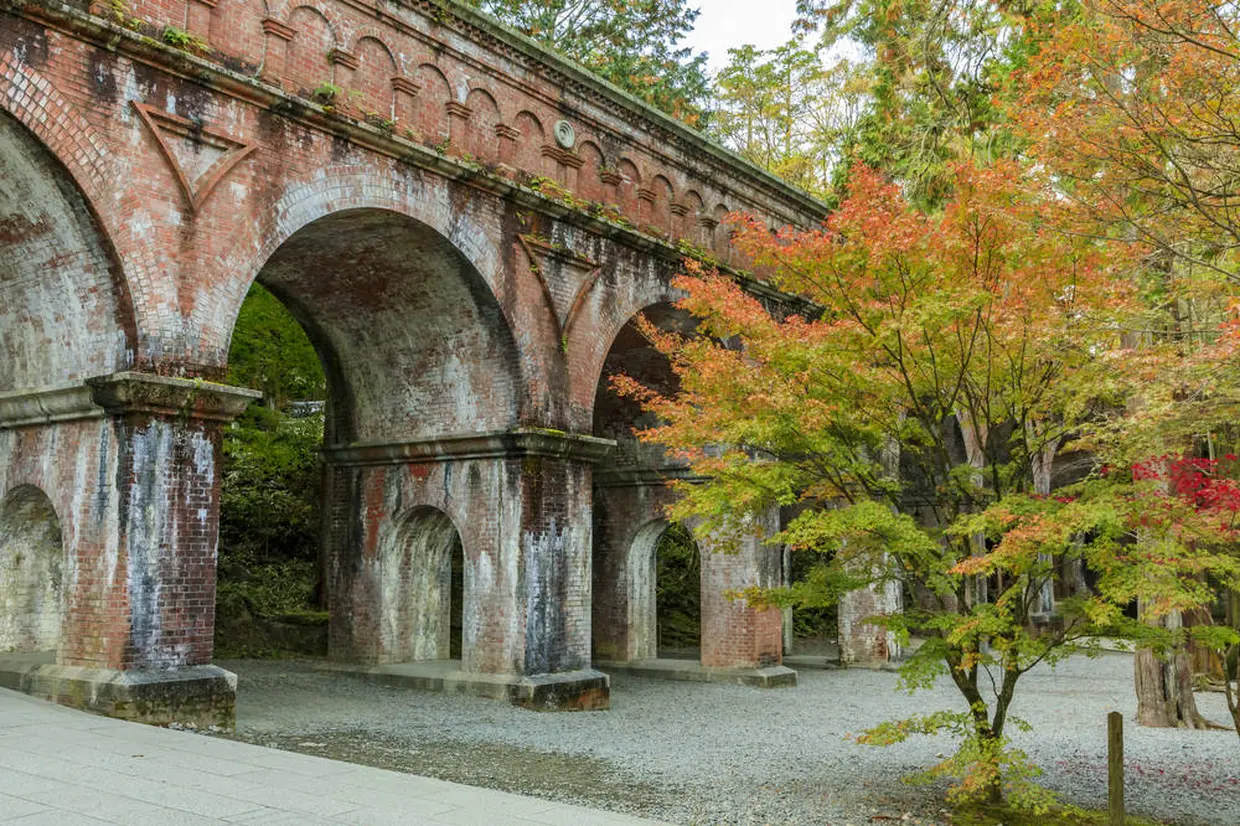
One particularly popular spot at Nanzen-ji Temple is Suiro-kaku, a brick waterway built. This structure, which has a different atmosphere from other buildings, was built during the Meiji period (1868-1912) to carry water from a canal. Today, it is a representative photogenic spot in Kyoto, often appearing as a location for TV dramas and movies
Karasuma-Oike, Shijo-Kawaramachi, Nijo-jo Castle area
The area around Karasuma-Oike, Shijo-Kawaramachi, and Nijo-jo Castle is the busiest district in Kyoto City. Department stores, apparel stores, restaurants, and other stores line the streets, and the latest Kyoto trends are concentrated here. However, it is not all new, which is typical of Kyoto. The Nishiki Food Market has a history of about 400 years, the alleyways have a Kyoto-like atmosphere, and there is a mix of old and new, from long-established stores to stores that are using modern architecture from the Meiji era.
Kamogawa Noryoko-Yoko, Pontocho, Nishiki Food Market Shopping Street, Nishiki Tenmangu Shrine, Kyoto International Manga Museum, SAMUEAI and NINJA MUSEUM with EXPERIENCE, etc.
Pontocho (先斗町)
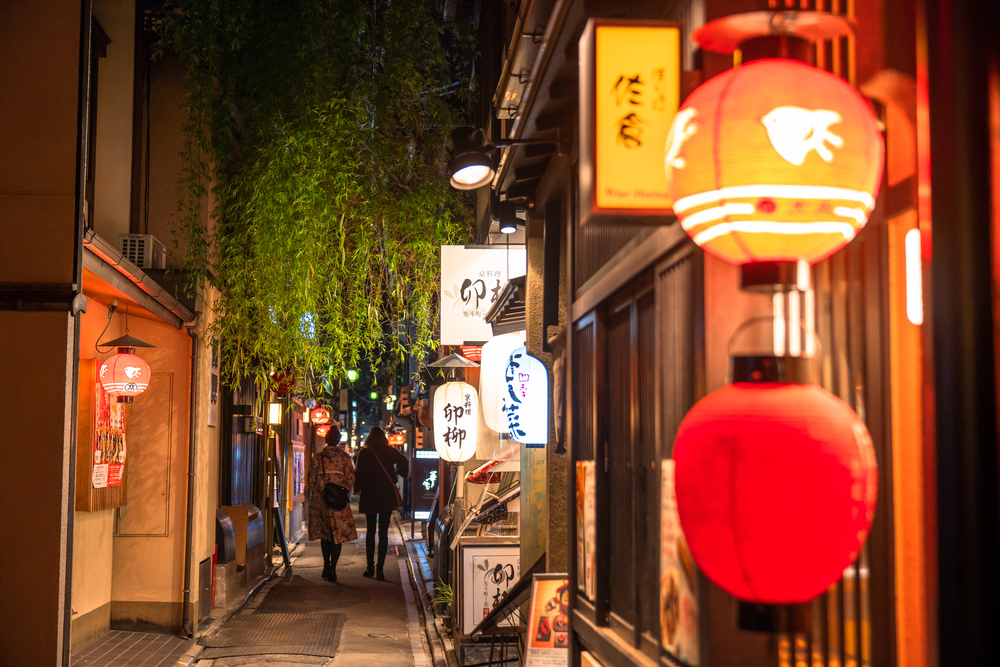
Pontocho is a narrow north-south street along the Kamo River from one street south of Sanjo Dori to Shijo Dori. The narrow alleys are lined with restaurants, ranging from traditional restaurants and tea houses to Italian restaurants and bars. The narrow streets lined with lanterns are very Kyoto-like, and you can feel Kyoto just by walking down the street.
Nishiki Food Market Shopping Street (錦市場商店街)
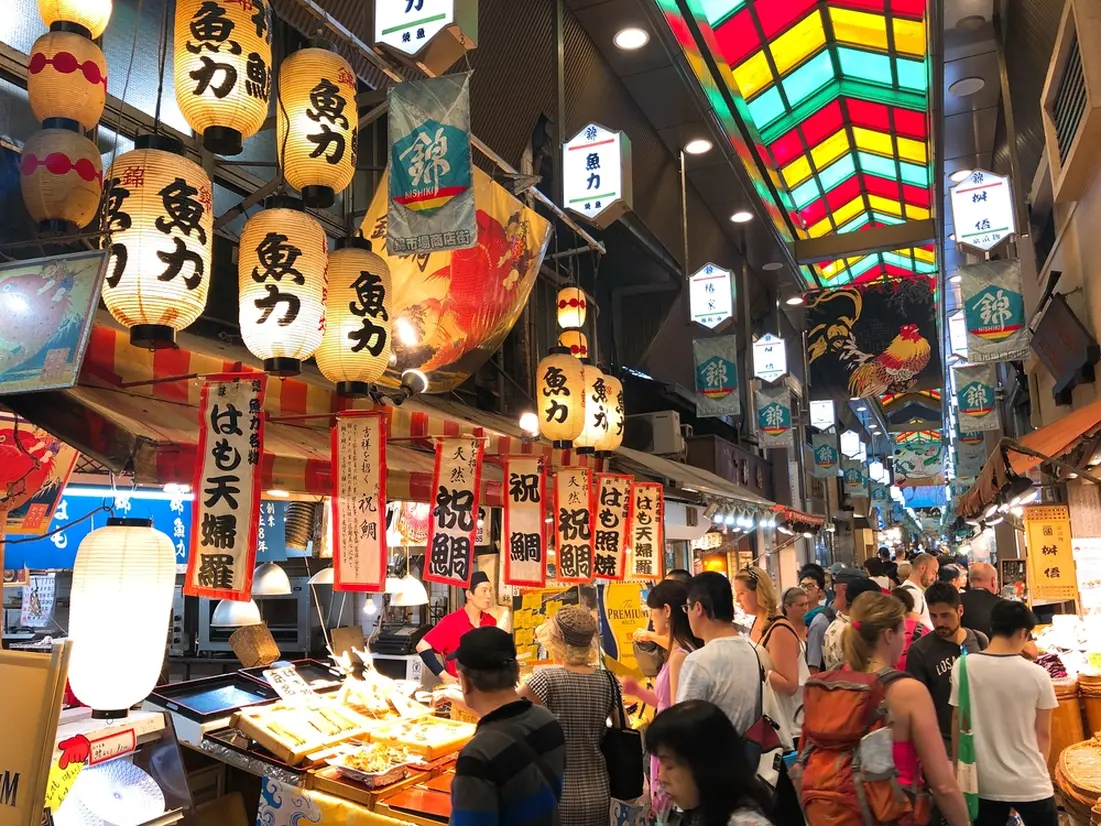
Also known as “Kyoto’s kitchen,” this shopping street has become a tourist attraction crowded with tourists and students on school excursions. It is also popular among foreign tourists as a spot where they can feel the bustling atmosphere of a good old Japanese shopping street.
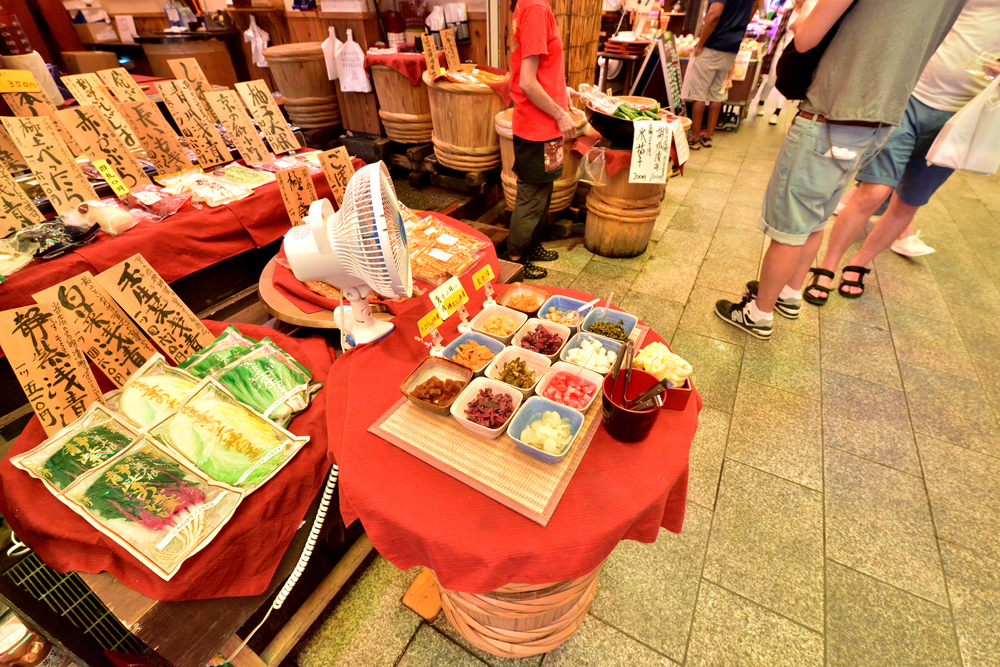
Within the 390-meter-long street, food items to take home as souvenirs such as kyoyasai (Kyoto vegetables), Japanese Pickles, tofu, and seasonal ingredients are sold, and there are also gourmet foods that can be eaten on the spot, making it easy to stop at each store one by one. The market also has a roof over the ceiling, making it a great spot to visit on rainy days.
Nijo-jo Castle (二条城)
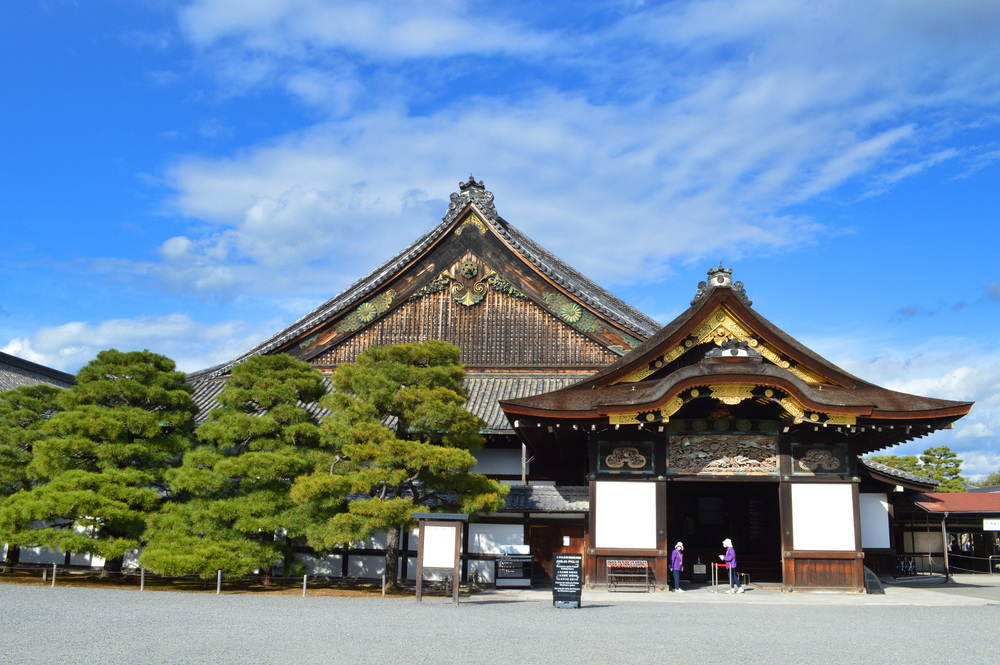
Nijo-jo Castle was the building noticed by the first shogun of the Edo period, Tokugawa Ieyasu, as a place to stay when he came to Kyoto, and it is also the place where he announced the end of the Edo shogunate, which lasted for about 260 years. Nijo-jo Castle, the very place of the rise and fall of the Tokugawa family, the shogunate family that flourished during the Edo period, is a precious place where many cultural assets and scenic spots can be seen, including the Ninomaru-goten Palace, a national treasure.
Kyoto Station Area
Around Kyoto Station, the gateway to Kyoto, there are many popular tourist attractions that will satisfy the curiosity of both adults and children, including the landmark Nidec Kyoto Tower, famous temples such as To-ji Temple and Nishi-Hongan-ji Temple, Kyoto Aquarium, and Kyoto Railway Museum.
Kyoto Station, Nidec Kyoto Tower, Kyoto Aquarium, Nishi-Hongwan-ji Temple, Higashi-Hongwan-ji Temple, Toji Temple, Tofukuji Temple, etc.
Nidec Kyoto Tower(ニデック京都タワー)
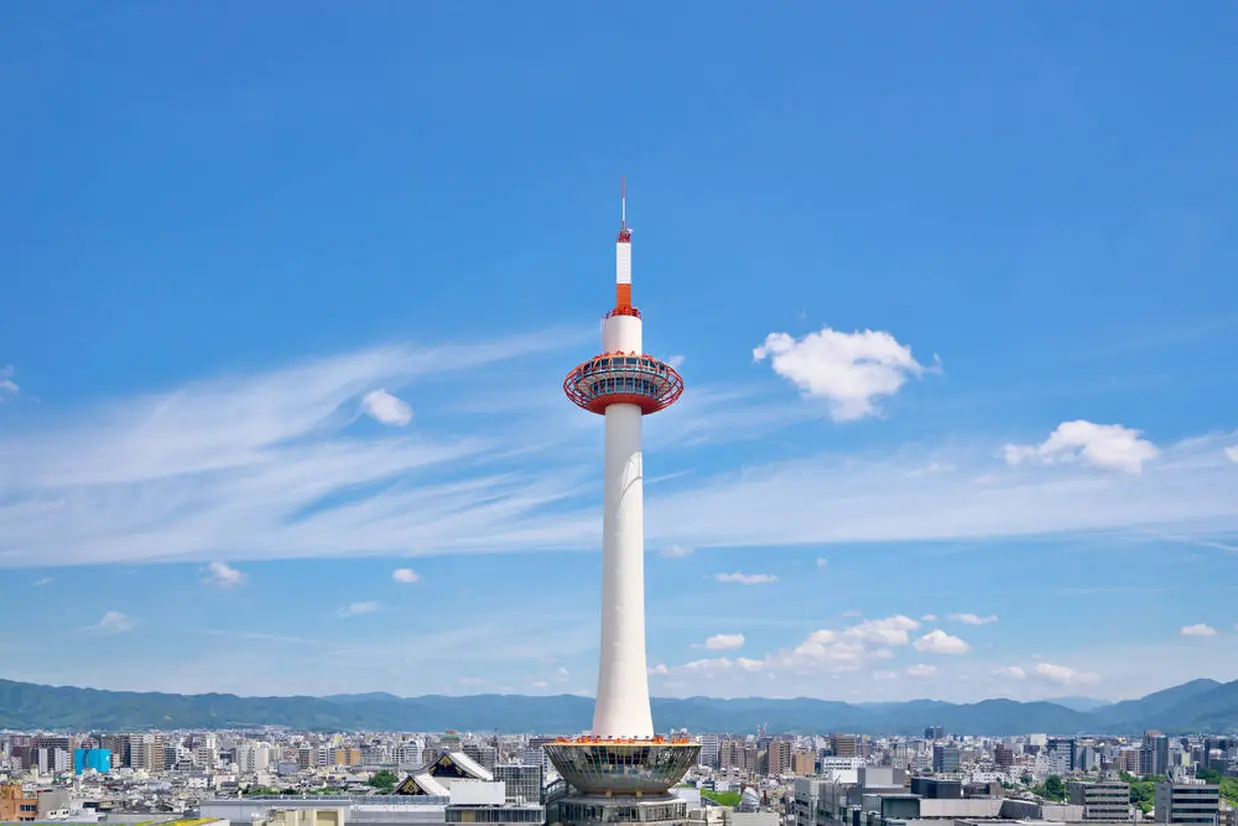
Kyoto Tower is a 131-meter observation tower built on the roof of the building in front of JR Kyoto Station. The tower’s graceful appearance was inspired by the image of a lighthouse illuminating the city of Kyoto. The observation deck is 100 meters above the ground and offers a panoramic view of the city of Kyoto, the surrounding shrines and temples, and the 36 peaks of Higashiyama. There is a hotel, restaurants, and a spot to purchase souvenirs.
Kyoto Aquarium(京都水族館)

The Kyoto Aquarium is located about a 15-minute walk from Kyoto Station. Although there is no ocean nearby, it is one of the largest inland aquariums in Japan, where visitors can enjoy dolphin shows.
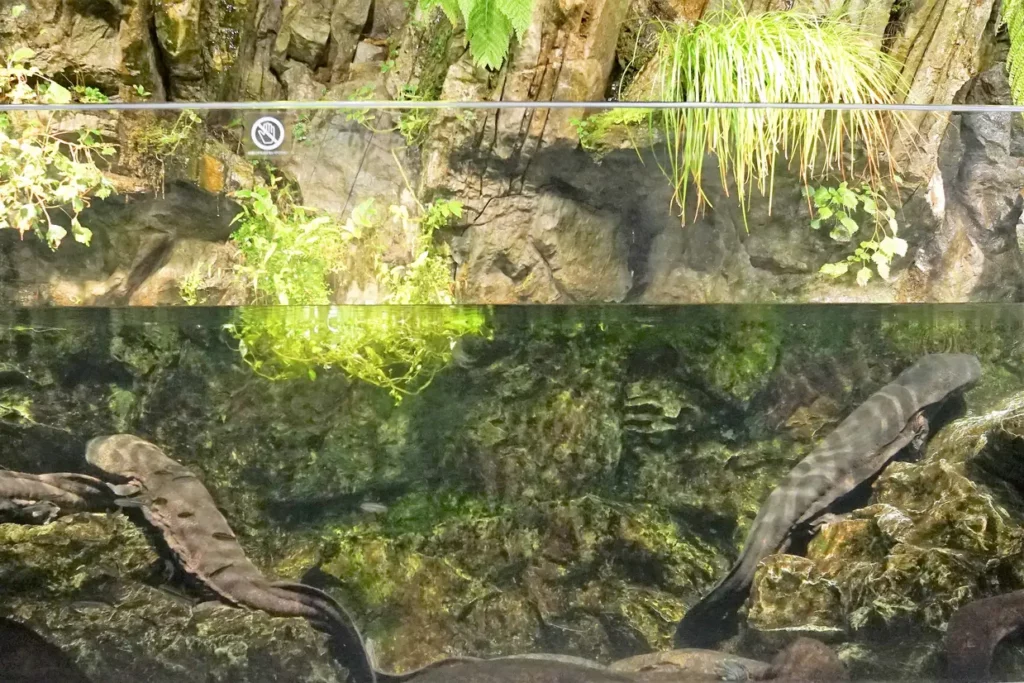
The centerpiece of the aquarium is the giant salamander, which has been designated a special natural treasure by the Japanese government. Visitors can observe the salamander, which is now considered a rarity, up close and personal.
Higashi Hongwanji Temple(東本願寺)

Higashi-honganji Temple, located not far from Nishi Honganji Temple, is one of the largest wooden buildings in the world, including the Goeido and the Goeidomon, as well as other buildings that are simply gigantic! You will definitely be overwhelmed.
The garden, located a short distance from the grounds where the building is located, is also a highlight, offering a beautiful view that varies from season to season.
Kurama/Kibune Area
Located in northern Kyoto, the Kibune and Kurama areas are quiet and full of nature, a short distance from the main areas of the city. The entire area is filled with a mystical atmosphere that offers a different sightseeing experience from that of the central area of Kyoto.
Eizan Railway, Great Tengu in front of Kurama Station, Kurama-dera Temple, Yuki-jinja Shrine, Kifune-jinja Shrine, Kawadoko in Kifune, etc.
Eizan Railway (叡山電車)

The Eizan Tramway, nicknamed “Eiden”, leaves from Demachiyanagi Station in Kyoto City. There are two lines: the Eizan Line, which runs toward Hieizan, and the Kurama Line, which runs toward Kibune and Kurama. The trains are also popular as sightseeing trains and the scenery from the train windows is a point of interest.
Great Tengu in front of Kurama Station
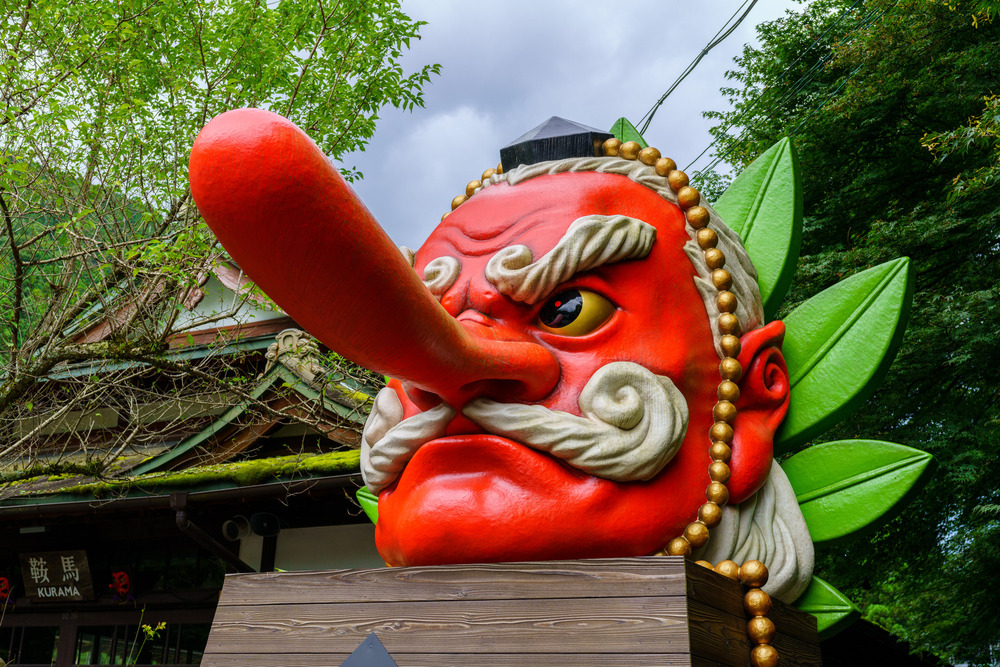
The first thing you will encounter when you get off at Kurama Station on the Eizan Railway and descend to Kurama is this giant tengu. It is a huge monument, 4 meters high from its base, and its nose is 1.3 meters long. Kurama is a place where legend has it that tengu live. When you exit the station and see this giant tengu, you will feel as if you have come to Kurama.
Kifune-jinja Shrine (貴船神社)

Kifune-jinja Shrine is the representative shrine of the Kibune area. Kifune-jinja Shrine, with its impressive vermilion lanterns lining the stone steps, is dedicated to the god of water.
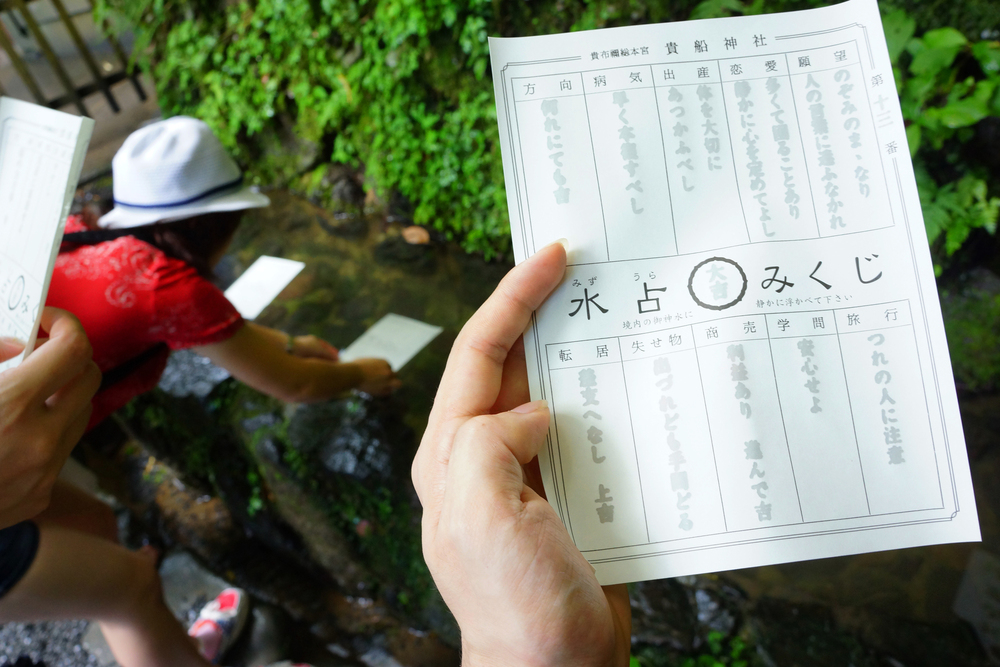
If you come to Kifune-jinja Shrine, you should definitely experience “mizuuranai-mikuji,” a fortune telling technique associated with water. Float a fortune-telling paper in the sacred water, and the result of the fortune-telling will come to the surface. Kifune-jinja Shrine is also famous as the god of marriage, and is said to guide not only love but all kinds of relationships in the right direction.
Ohara Area
Located in the northeastern part of Kyoto City, the Ohara area can be reached in about 70 minutes from Kyoto Station by bus only, or in a little over 40 minutes by train and bus. The area is dotted with historical sites in a tranquil landscape, allowing visitors to enjoy a leisurely stroll and experience nature and Kyoto-like visits to temples and shrines at the same time.
Sanzen-in Temple, Hosen-in Temple, Jikko-in Temple, Jakko-in Temple, Ohara Onsen, Sato-no-eki Ohara, etc.
Sanzen-in Temple (三千院)
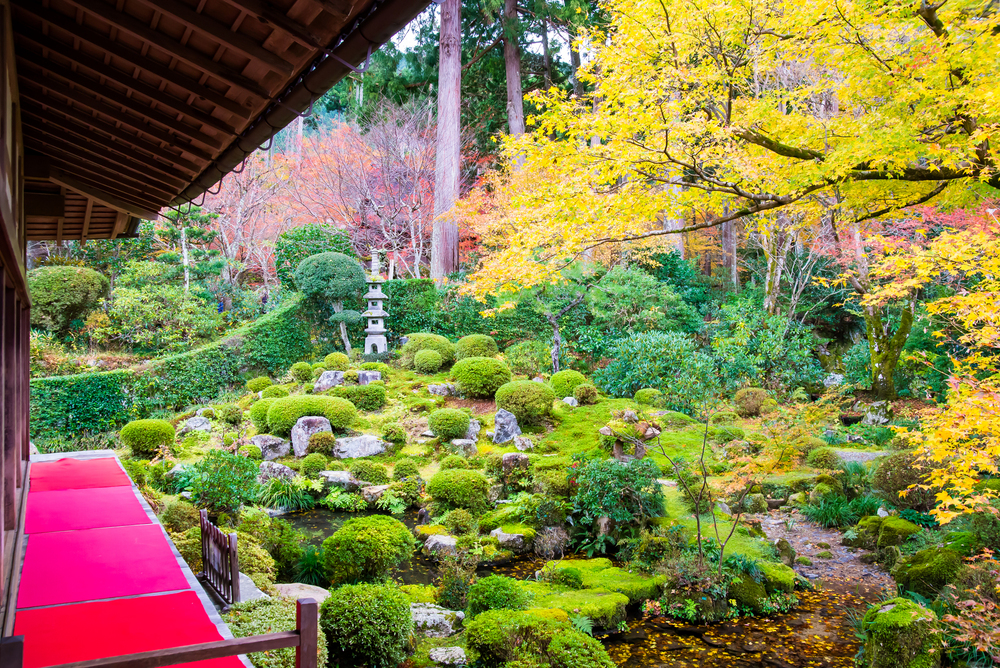
Sanzen-in Temple has a history of over 1,200 years and is a symbol of the Ohara area. Two gardens are highlights of Sanzen-in: the first, Shuheki-en Garden, where you can enjoy the beauty of nature from the tea ceremony table, and the second, Yusei-en Garden, with its beautiful mosses. In addition, many Buddhist statues are enshrined and many cultural assets are on display.
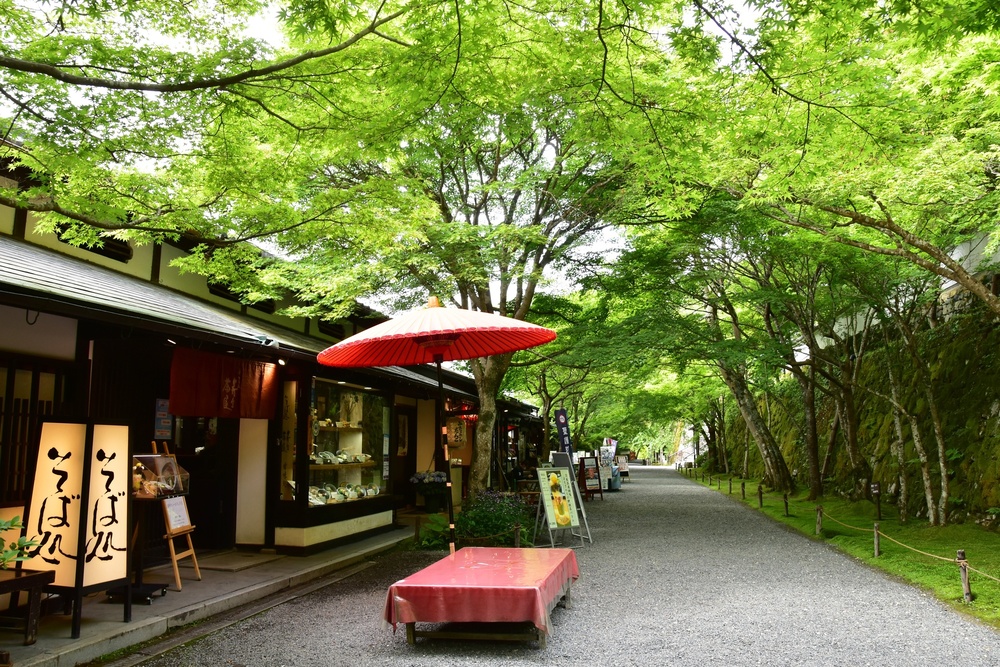
The approach to Sanzen-in Temple is also lined with souvenir stores and restaurants. The approach to the temple is also famous for its autumn foliage, which attracts many visitors during the autumn foliage season.
Hosen-in Temple (宝泉院)
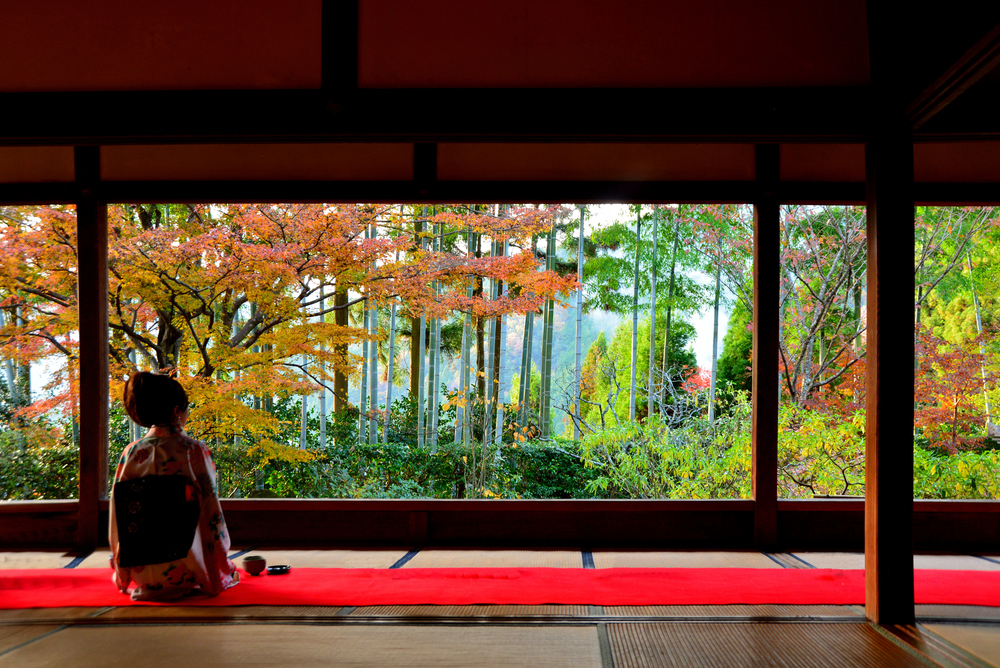
Hosen-in Temple is the best place to visit in combination with Sanzen-in Temple. The garden can be viewed from the Shoin, which is known as a “frame garden” because the space between the pillars is used as a frame for viewing the garden. The entrance fee includes matcha green tea and fresh confections, so you can enjoy a Japanese meal while admiring the garden.
Jikko-in Temple (実光院)

Jikko-in Temple has a garden where visitors can enjoy seasonal flowers. The Fudan-zakura cherry trees, which bloom from fall to spring, are rare in Japan and are a must-see. Matcha green tea and fresh confections are included in the entrance fee, and can be enjoyed while admiring the garden.
